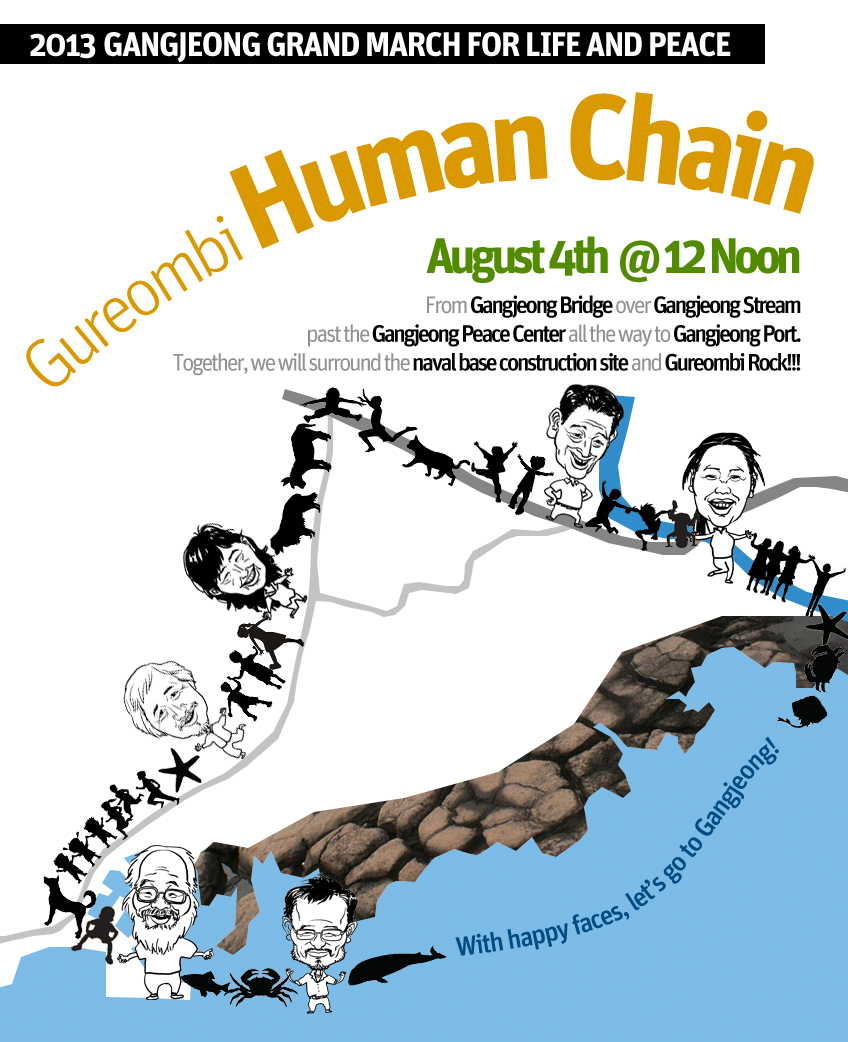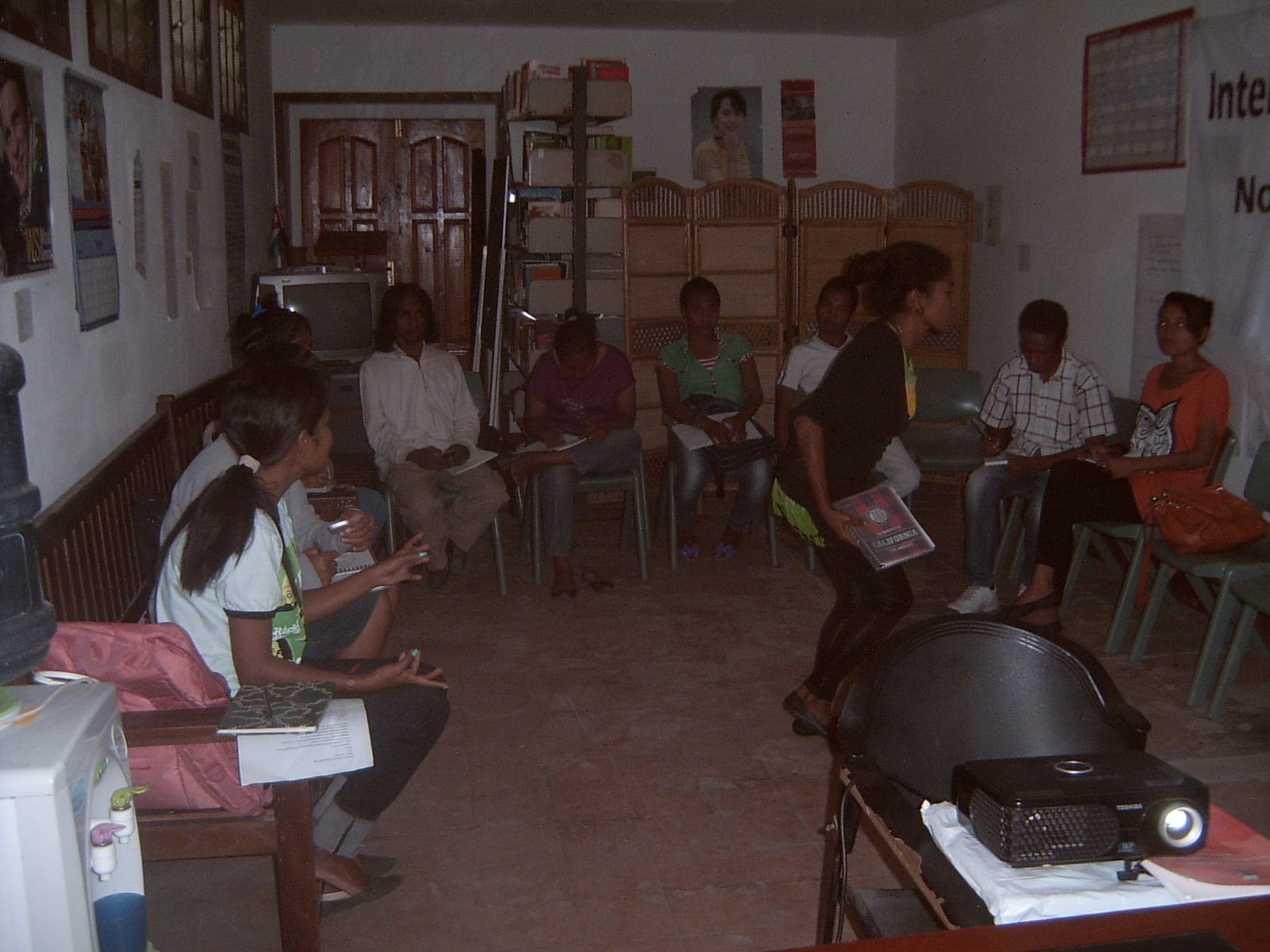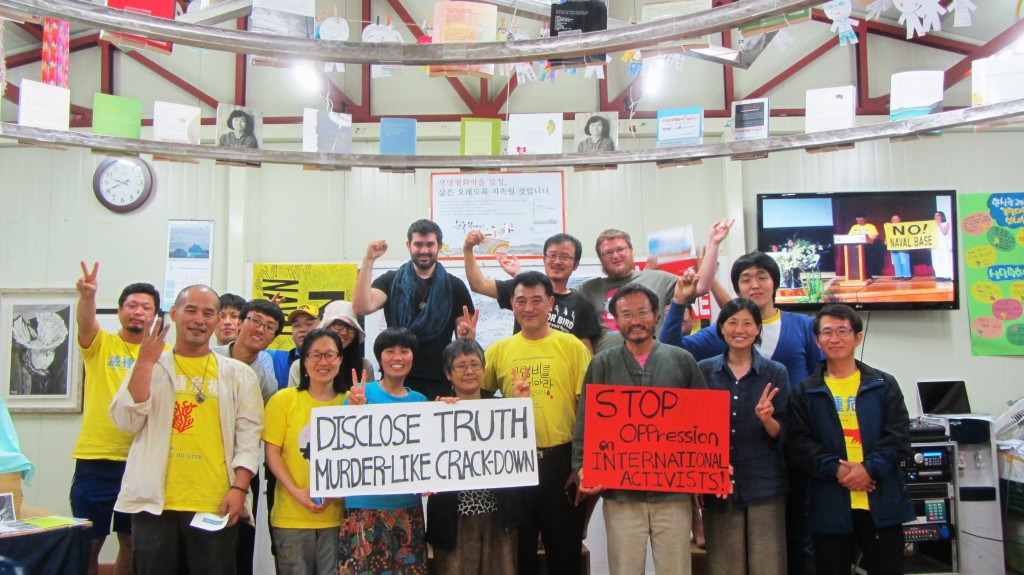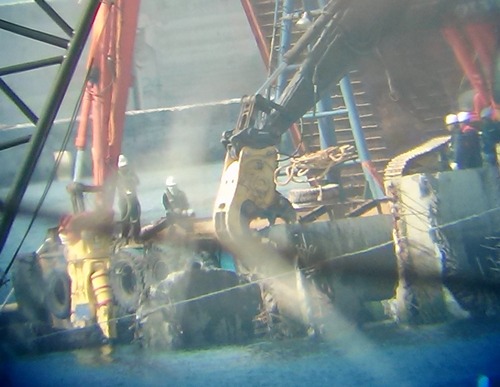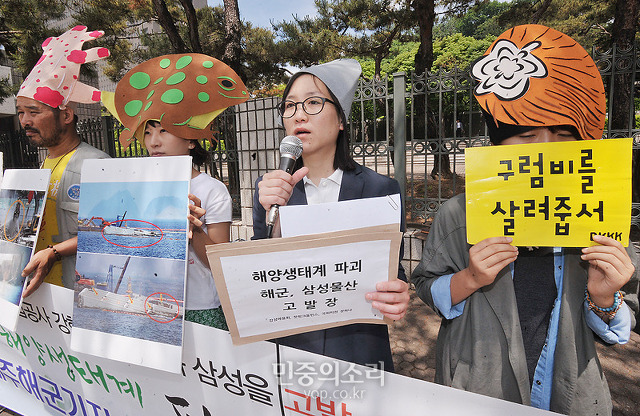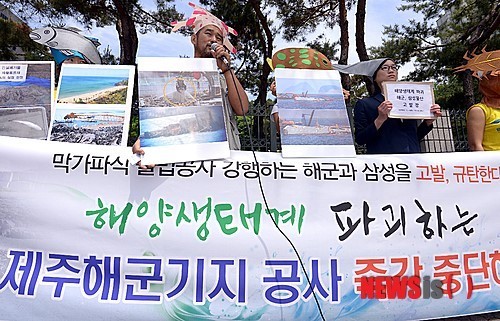In this month’s issue:
Arrest of Dr. Song and Brother Park, August 4th Human Chain, Timor and Lanyu Solidarity, Peace Pilgrimage, Prisoner and Trial Updates, Dr. Song’s article from Prison, Art Activism, and more!
Save Jeju Now
No War Base on the Island of Peace
Category: Featured
-
Please join us! A Gureombi Human Chain in Gangjeong on Aug. 4!
Please spread!
At the end of 2013 Gangjeong Grand March for Life and Peace (July 29 to Aug. 4), there is a huge and memorable human chain event for two hours in Gangeong village from noon to 2 pm on Aug. 4!
The human chain is a succession of people’s daily human chain in front of the Jeju naval base construction(destruction) gate after daily Catholic mass and Gangjeong dance in protest to stop the Jeju naval base construction.
Two more prisoners of Dr. Song Kang-Ho and Br. Park Do-Hyun! All four prisoners including Yang Yoon-Mo (the court added him fines of 2 million KRW on June 25, which means he would spend 39 days more of prison labor. Because of that, he would be released in May, 2014, not April, 2014) and Kim Young-Jae (the court dismissed people’s appeal for bailing on him on July 8) ! The daily struggle to stop the Jeju naval base project is being continued in Gangjeong.
Peace-loving internationals, even though you may not be able to physically join, please join our human chain in spirit! HOW?
_ You may hurry to mail us some souvenir such as your t-shirts or whatever that can represent you with your name/ messages put on those. We will put those in our human chain. Please see the photos and videos below. OR
_You may send us solidarity messages(up to 100 words)/ photos/ videos no later than July 20. Please see last year’s here.
_Contact: gangjeongintl@gmail.com
We especially encourage all the peace-loving internationals who have been forcefully deported by ROK government or being threatened to be deported to join us! (To see the status of deported internationals, see here)
All the names will be put at the ending credit of Director Cho Sung-Bong’s documentary, “Gureombi Wind blows.” Dir. Cho plans to take air shot of huge human chain event on the day.
Noon on Aug. 4, 2013
Jeju naval base main construction gate -naval base project committee building complex gate-Peace Center at the Sageori( four way intersection)-Gangjeong port
People in happy faces are to go ALL to Gangjeong to Join the HUMAN CHAIN to HUG GUREOMBI ROCK!
(translation of poster)

Photo fwd by Choi Hye-Young. people’s daily human chain in front of the Jeju naval base construction(destruction) gate. Let’s see all in Gangjeong on Aug. 4. All of you can join us in spirit! 
Photo by Kim Dong-Won/ Gangjeong is endangered. A peace keeper hung a photo of a villager in his childhood. We dream every life visible and invisible to join our grand human chain event on Aug. 4! For more photos, see here. 
Photo by Kim Dong-Won/ Every t-shirt or whatever souvenirs you mail to us can represent you. The t shirt is owned by a peace keeper who struggles daily. In that way, we want to represent all the prisoners, deported internationals whom we want to be together in our huge human chain event. For more photos, see here. People’s promotion video: Please join our human chain to stop the Jeju naval base project on Aug. 4!
Video by Peace Nomad (source)
Stop the building of war base!
Boycott Samsung, the most criminal company for the Jeju naval base project!
Stop the oppression on international peace workers!
Free all the conscientious prisoners in Gangjeng!
As of July 11, 2013
Yang Yoon-Mo (No. 301, 161st day in prison)
Kim Young-Jae (No. 435, 91st day in prison)
Dr. Song Kang-Ho(No. 409, 11th day in prison)
Br. Park Do-Hyun (No. 535, 11th day in prison)
Please write letters to the Jeju Prison, 161 Ora-2 dong, Jeju City, Jeju, the Peace Island, Korea
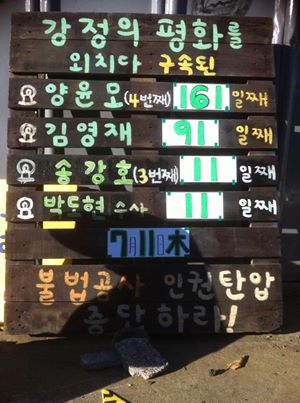
Photo by Kim Koon, July 11, 2013
-
Gangjeong, a peace pivot, for the 60th remembrance year of the Korean War Armistice
Upon the year marking the 60th anniversary of the Korean War Armistice, people’ steps for peace amid the escalating war threat in Korea are marking their ways such as through petition, peace tour and peace pilgrim.
One of those steps have been the Peace Tour, organized by about 60 people of domestic and international scholars on the Korean War and civic activists, from June 28 to July 1. Another step of peace pilgrim started on July 4, which ends on July 27, the 60th anniversary date of Korean War Armistice. The latter was organized by an international grand peace march group composed of organizations such as the Citizens’ Act to Oppose War and to Realize Peace and the Jeju headquarter of the South Committee for the Practice of 6.15 Joint statement.
The former ended its peace tour in Gangjeong on July 1 while the latter started its peace pilgrim in Gangjeong on July 4. Gangjeong is now one of people’s ‘pivots’ to face against Obama’s ‘Asian pivot:’ A peace pivot, a peace outpost to realize the peace in Korean peninsula and Northeast Asia.
The 2013 Gangjeong Grand March for Life and Peace, from July 29 to Aug. 4 with its eve festival on June 28 will succeed people’s such peace aspiration.
1. Peace Tour: Marking the 60th Anniversary of the Korean War Armistice (June 28 to July 1)
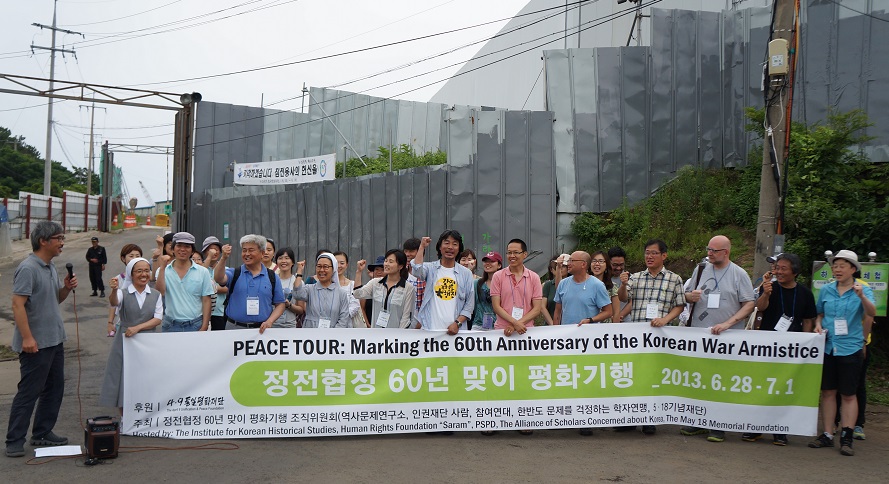
Source: PSPD/ The ending day of Peace Tour, June 28 to July 1 The former, the Peace Tour hosted by the Organizing Committee for Peace Tour marking the 60th Anniversary of the Korean War Armistice were composed of the Institute for Korean Historical Studies, Human Rights Foundation “Saram,” People’s Solidarity for Participatory Democracy(PSPD), The Alliance of Scholars Concerned about Korea(ASCK), and The May 18 Memorial Foundation.
The Peace Tour that started with keynote speeches by Fr. Mun Jeong-Hyeon and J. T. Takaki, in the former KCIA site in Namsan, Seoul, went through Korean division sites such as Jeokgoonmyo (enemy’s Cemetery), Story Firing Range, Gwanghwa Peace Observatory; US base sites such as Pyeongtaek, Daechuri; and war and dictatorship massacre sites such as Nogeun-ri, Geochang, Gwangju.
Seminars were held three times during the tour: 1. Division, Life: 2. US Military and the Korean peninsula; 3. War and Massacre.
In the tour’s last spot in Gangjeong, a Peace Declaration concluding tour was read in front of the naval base project committee building complex. Please see here for the whole statement and following resolutions (Please mouse down until you see the English part)
Here are some excerpts:
[..]On the 60th anniversary of the armistice, the “peaceful solution” called for in Article 60, Section 4 of the Armistice Agreement has yet to be realized. Instead, without a peaceful resolution, the physical and psychological pains from the war persist to this day.
[..]Gochang and Jeju Island, we visited the sites of extreme state violence not just in wartime, but also in the years leading up to and after the Korean War; and in Gwangju, we saw that similar violence was repeated under the Armistice system. Witnessing the construction of a new naval base in Gangjeong, we were reminded of how the state of war between North Korea and the U.S., and between the two Koreas, provides justification for future conflicts, with islands in the Asia Pacific, including Jeju, serving not as bridges of cooperation, but as frontline bases.
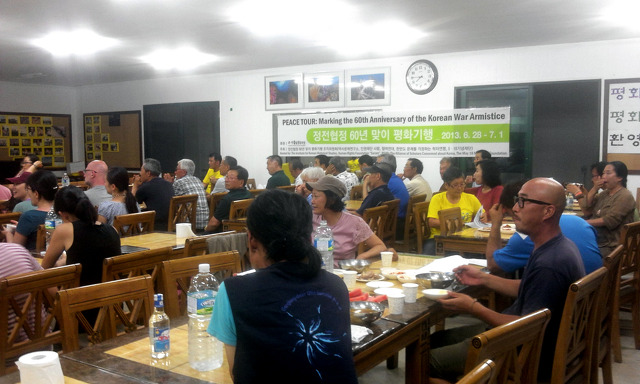
Source: Save Jeju Now/ The Peace Tour team had a talk meeting with the Gangjeong villagers and peace keepers in the evening of July 1. 2. An international peace march to realize the ‘Peace Agreement’ (July 4 to 27)
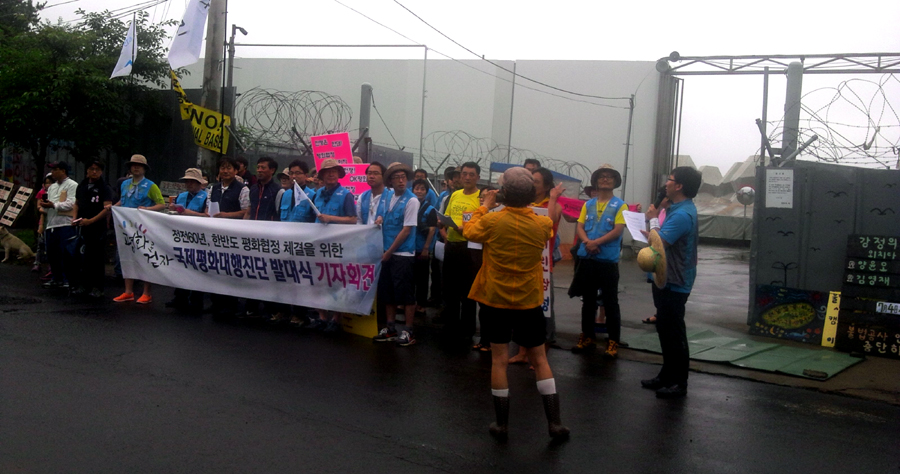
Photo by Save Jeju Now/ International peace pilgrim’s launch ceremony in front of the Jeju naval base construction(destruction) gate. For more photos, see Voice of people About 20 people of the international peace march group started 25 days’ great march after their launch ceremony for the ‘international great peace march to realize the peace agreement, upon the 6oth anniversary of Korean War Armistice,’ in front of Jeju naval base construction main gate in the morning of July 4.
They demanded ‘prompt conclusion on the peace agreement,’ and ‘resumption of posed talks and negotiations with North Korea.’
They saying that, “under unstable cease fire regime, you cannot stop the horror of war and cannot realize peace,’ claimed that ‘peace agreement should be definitely concluded to completely finish the war in this island.”
They also added that talks and negotiations such as six party talks, NK-US talks and ROK-NK talks should be promptly resumed for the peace of Korean peninsula.
The march spots include sites of pain from war and massacres , including cobalt mine in Kyungsan, Nogeun-ri, Choongbook, and Jiri Mt. (source)
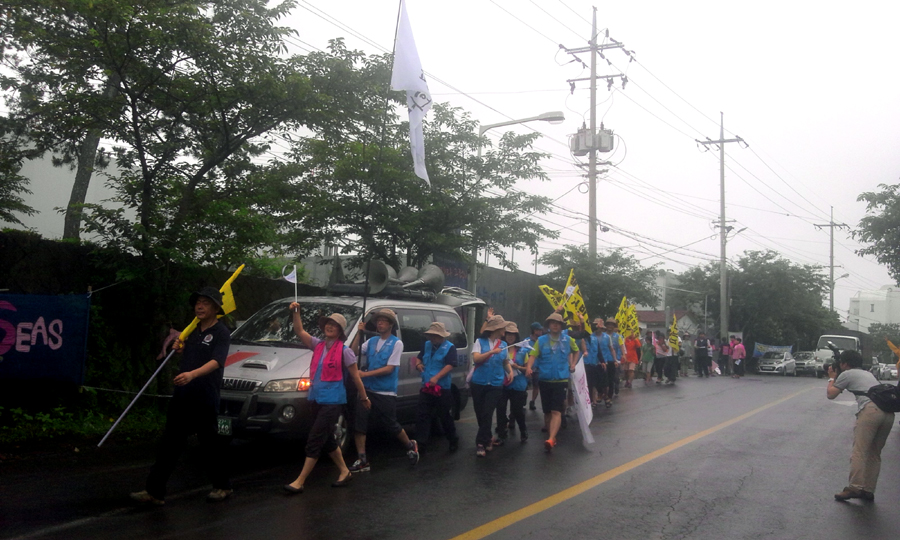
Photo by Save Jeju Now on July 4, 2013
-
Inter-Island Solidarity Trip in Timor-Leste
Emily, the Deported Gangjeong Peace Activist, has just visited Timor-Leste to share (1) the Gangjeong’s struggling stories and through this sharing, she also talked about (2) the ideal of Inter-island Solidarity for Just Peace.
This video, Gangjeong in 2012, is translated into Tetun, the most popular language in Timor-Leste, and was used in the sharing in Timor-Leste.
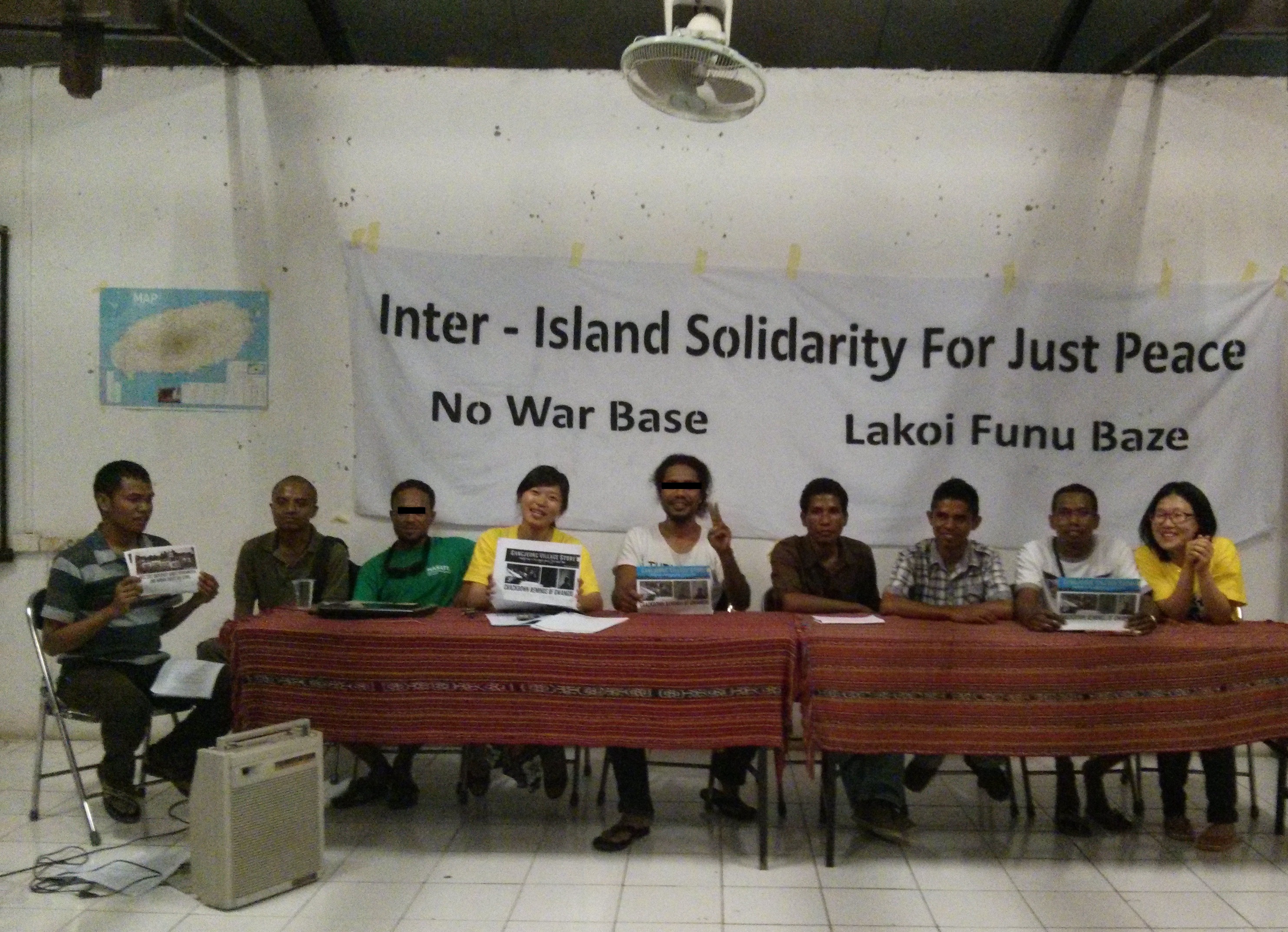
Inter-Island Solidarity for Just Peace from Timor-Leste From this visiting she also learned that the American navy has tried to take the Atauro Island of Timor-Leste to be its naval base, but so far, not yet succeeded to persuade the government of Timor-Leste. This is an alarm for the newly-independent country Timor-Leste in this trend of islands’ militarization.
Emily met the Human Right Group, Group of Women Peace and Leadership, and the university students and graduate students in the University of Timor Lorosae. These Timorese friends were really amazed by the ongoing struggle of Gangjeong and be more aware about the issue of the militarization in lots of islands.
The following is Emily’s speech especially on inter-island solidarity for just peace in Timor.
——————————————–
Dear friends of Timor,
I am Emily Wang, a peace worker from Taiwan but I have ever worked in Timor island, Jeju island and Taiwan island. Today I am especially happy to be in Timor-Leste again as Timor is where I started to dream to be a peace maker.
Among the places where I have ever stayed and worked for quite a while, there’s one obvious common element. Is there anyone noticing about it?
Yes, Jeju, Taiwan, Timor all of them are island! But today, I will more focus on the island in North East Asia, including Taiwan, my hometown, and Jeju where I’ve lived for almost 2 years, and Okinawa. Even though I haven’t got chance to visit Okinawa for deeper understanding, many Okinawa people have visited Gangjeong and shared their stories. These three islands are geographically close to each other, and thus when we review the island history by viewing the interaction or relation between these islands and other big powers, you may also get some clue about the reason why I and my co-workers are working to contribute for inter-island solidarity for just peace, and then hopefully, from my sharing, there will be some seeds to grow in the future among us.
Not until my life journey was trapped in Gangjeong, I have been forced to realize and learn lots of hidden stories in the history I used to learn. You know what I am so much surprised that I’ve never realized about Taiwan and Korea’s connected past and present, and I can say most people in Taiwan or Korea haven’t got chance to realize it. Actually, we don’t learn the Korea and Japan’s history in our compulsory school education. Only if the Korea or Japan appeared in the history of China, then the book may have some space for that incident. The history student learned in school in ROC (Taiwan), ROK, and Japan are written on the unnaturally isolated basis of state. Which means we are forced to view our history on the isolated basis of state, and unconsciously, we are divided unnecessarily. The stories which I should have noticed are stolen by an invisible hand.
For I started to realize that, I was motivated to study about the missing history from a missing angle, and I will bring you to a quick history journey in our region through the angle of Island.
For the presentation in Timor, I made the form to compare the history of islands. Thanks for you guys! Because the desire to share our history with you gives me a chance to learn again my history and I just realized a lot of parts of histories before I came to Timor!
Taiwan Jeju Okinawa Timor In the past, independent island with diverse indigenous people’s tribal culture. Some Han people immigrate to Taiwan.Colonization by Dutch, Spain, and then Chinese regime with lots of Han people’s immigration to Taiwan. In the past, independent island regime until 12, 13 century, swallowed up by mainland.In the long time ago: battle ground of big countries (China, Japan, Korea, Mongolia…) In the past, independent island regime. Tributary state to China. In 1609 Satsuma from Japan invaded Okinawa, then Okinawa deftly served both China and Japan.Diverse culture: local culture plus big influence from China and also Japan. 16th century, Portuguese came17th century, Dutch came. West Timor and other island colonized by Dutch between 17th-19th were known as the Dutch East Indies. Japan imperialism’s colonization(1895-1945) Japan imperialism’s colonization(1910-1945 ): Japan imperialism’s colonization(1879-) Japan imperialism’s colonization (1942-1945) During war time: Kominka movement(Assimilation policy and a campaign to totally transform the Taiwanese, Okinawa people and Korean into loyal subjects of the Japanese Emperor between 1937 and 1945.) Island colonies to be militarized, to be exploited for the war preparation and to be used as bases and then victimized
Towards the end of World War II, Taiwan as the colony of Japan became the target of Allied, for example, Taipei Air Raid. The number of deaths totaled more than 3,000, Tens of thousands of people were displaced or became homeless, and many buildings were destroyed either by the attacks or by the fire caused by the attacks. After the conclusion of World War II, because of its pro-American political stance, the government of Republic of Chinatoned down the attack and excluded it from the media and history textbooks. Towards the end of World War II, the Japanese heavily fortified the island, deployed 70,000 soldiers, and forced the islanders to construct coastal defenses in anticipation of a U.S. invasion. Towards the end of World War II, the Japanese fortified Okinawa in hopes of thwarting the Allied advance on mainland Japan. U.S. forces, prior to Hiroshima and Nagasaki, saw Okinawa as an ideal location from which to launch potential ground and air attacks against Japan.Okinawa experienced the only ground battle in Japan during World War II. Lots of Okinawa people died and dislocated, lot land… The end of World War Two:- The end of Japanese colonization- Expectation to build up a new society but… The end of World War Two:- The end of Japanese colonization in both Korea peninsula and Jeju.- Expectation to build up a new society but… The end of World War Two:- expectation to build up a new society but… The end of World War Two:- 1945, Portuguese Timor – Civil War in China- KMT’s exploitation was like a second colonizer. – In 1947, 228 Massacre – 1948 KMT government launched martial law, Pro-US military dictatorship was establishe– 1949 KMT lost civil war and retreated to Taiwan._ 1950 Korea War broke out, and US Seventh Fleet was send to Taiwan Strait – Soviet Union and US occupation of north and south Korea – North Korea government firstly built in 1945 but US dislike it. In 1948, with U.S. and U.N. support, South Korea held elections that established a separate Pro-US government in the south, thus solidifying Korea’s division. – In 1948, 43 Massacre – Occupation by US military- Under the impact of Cold War, the budget for US base construction in Okinawa was passed.- The United States would administer Okinawa but its inhabitants would retain Japanese to svoid criticism of colonization which is good for Japan and US - Okinawa is excluded from the Peace constitution. The history in Okinawa after world war two is very different from the history in other region of Japan
– The Okinawa people started movement to be returned back to Japan
– ? – Cold War
– Since middle of 1950’, all the military bases in Taiwan provided for US military to use, especially during Vietnam War (1965-1971), around 20,000 US soldiers stationed in Taiwan.- Since 1967, Taiwan was designated as a holiday place for US Army.- White Terror- Economic growth because of War – Because of Cold War, lots of US army and base in Korea.- Korean army also sends to Vietnam war…- White Terror- Economic growth because of War – Important US base during Cold War- 1972 US relinquish Okinawa to Japan but the base remains. It shows Okinawa’s victimized role in the US-Japan Security Relationship. Okinawa people realized returning back to Japan is not the point, but military base is the point to fight.- Impoverished by US military administration and started “Base economy” which means islanders relied on the base to survive as the original way of living was destroyed. – In 1974, after the fall of Portuguese fascist regime, independence was encouraged by the new democratic Portuguese government.- legalise political parties in preparation for elections to a Constituent Assembly in 1976.- Fretilin was criticised by many in Australia and Indonesia as being Marxist. The United States had also expressed concerns over Portuguese Timor- 1975 Indonesia Invasion China Growth or China Threat / How to face China and how to face each other in our region where the decolonization process was intervened through violence? By holding US’s military hand, we don’t need to face each other!
– 1971, ROC(Taiwan) was kicked out from UN- 1979, US Taiwan Relation Act (US continue to sell weapon to Taiwan and promise Taiwan that in Emergency situation to secure Taiwan)- Taiwan is in a weird situation… (for example: buy the weapons from US and support the US’s war even contributed to the killing in East Timor…)- China and US both cannot tolerate Taiwan to be militarily used by each other, – US base in Korea’s function is not only for North Korea but largely for China.- Relocation of the base in Korea for the strategy flexibility (eg. Pyeongtaek base)- Jeju Naval Base – US base in Okinawa’s function also for China President Obama: Asia Pivot (Rebalance the US focus to the Asia pacific area)- Islands in Asia Pacific area will be more highly militarized- Missile Defense System – an important part of America’s first strike strategy. It serves as a shield for US to prevent the retaliatory action if the first strike were launched.- Who are the targets?# Russia owns the richest natural gas provision and a large portion of the petroleum# America is getting difficult to compete with China economically. How to control China’s economic engine? China imports over 60%’s petroleum through the shipping.- Korea, Taiwan, Japan are all part of the MD system, and the MD system’s Aegis Warship will be stationed in Australia, Japan, Guam, South Korea. Jeju island will be the naval base with Aegis Warship. – How about Timor-Leste?- Are you safe?- Atauro’s future? Before the world war two, many of the people in East Asia had been experiencing a common struggle against the imperialism. But after world war two, the common struggling against imperialism was split into two under the cold war. During the World War Two, Islands like Taiwan, Okinawa, and Jeju were unwillingly militarized as the colonies of Japan, but these victimized islands were attacked by America military, the Allied, for attacking the mainland of Japan.
After the World War Two, no time and no need to face peace and justice issue in our region as all of us have to face the cold war together with the US. During the cold war, dividing and dominance in our region was the strategy of US. North East Asia was divided into two sides, and to foster the side of the US partners in our region during Cold War, the Pro-US governments were demanded by the US. That’s why the US installed a new Pro-US government in South Korea and contributed to the division of Korea. And also for US’s interest, the partner countries of US had better to be stabilized to be the US side. Thus, the Pro-US government must have the ability to eliminate the different voices, so the US backed up the Pro-US government’s bloody dictatorship by supporting lots of weapons and military, and money!
Under that background, Pro-US military government in Taiwan and South Korea both suppressed the decolonization effort with the excuse of anti-communist, and the people in Taiwan and Korea both experienced the massacre, 228 massacre and 43 massacre in Taiwan and Jeju, which was both stigmatized as communist rebellion but long time later after both Korea and Taiwan ended the White Terror Era and went on democratization process, both truth of 228 and 43 incident were disclosed more and more.
For the effective social control, in South Korea, the US military and Korea dictatorship even worked together with the Korean vested interests who had served for Japanese colonizer to exploit the other poor Korean. So after world war two, these people back to their power again but this time, worked with US and Pro-US dictatorship to continue the strict social control for the reason of anti-communist.
In China, the KMT government lost the civil war in mainland China and retreated to Taiwan, Taiwan Strait between China and Taiwan become the Cold War dividing Line. One thing to notice is that the whole Taiwan island before the world war two was the colony of Japan, and after the war, Taiwan people experienced a very short cerebration and expectation of emancipation, and then got very much disappointed by KMT government as the Taiwan people were just again became the second citizen of government from mainland and the “self-governance movement” which has started since the Japanese colonization time got suppressed again by the KMT dictatorship government.
(One thing to notice is Korea and Jeju were all fell into the Japan’s colony together but Taiwan alone were given to Japan by Ching dynasty in 1895 after a lost of war between China and Japan, therefore during the World War two while China fought hardly against the Japan’s invading, Taiwan people were Japan’s colony second citizen, and Taiwan island was a land to be exploited for Japan’s imperialism war against China and other countries.)
At the moment when Taiwan’s people who settled down in Taiwan before the 1945 haven’t adapted themselves as “Chinese” yet, and then the Pro-US KMT dictatorship government made them feel they are not equal with “mainland Chinese” but second citizen again as “Taiwan Chinese”, and make Taiwan people thought that Japan and China are actually the same as colonizer. Some even hate KMT more.
There’s one more thing to notice here, when I mention “Taiwan people”, it means diverse group of people who live in Taiwan and other small island governed by Taiwan’s government now.
And the KMT’s lost of Civil War and retreating to Taiwan along with lots of immigration from mainland, due to the bad governance of KMT, these new immigrant people after World War Two had long been called as outsiders (people from other province, people who are not from Taiwan province), a discriminating calling mainly resulting from the dissatisfaction of decolonization and emancipation process. Except for the above-mentioned Han people, there’re indigenous people, the most discriminated group, became under the KMT’s governance. The indigenous people are not Japanese, not Chinese, so even in the emotional feeling, to be “returned” back to Chinese government is not a “returning” but simply just a new colonization by a dictatorship KMT government, for them, a worse colonizer than Japan.
In Japan, under the US military power, a pro-US and anti-communist government was built up too. Japan became US’s partner in cold war system, and it froze the Japan’s society to face the decolonization historical issues as an imperial colonizer and an invader in our region. This gave the militarism in Japan a big chance to be revitalized even after the disastrous war experience.
Okinawa, an originally independent kingdom having a diverse exchanging relationship with both China and Japan, became the imperial Japan’s territory in 19 century. And during the World War Two, due to Okinawa’s geo-graphical importance, Japan highly militarized Okinawa island, but still US military succeeded to take over Okinawa to make it an important jumping step to attack the mainland Japan. Thus, Okinawa being victimized by the powerful countries and experienced a bloody ground battle by US and Japan. After World War two, for its importance and convenience of military, Okinawa was continued to be occupied and directly governed by the US military but remained as Japanese citizen, a deal between US and Japan for their state interest. Okinawa, the only place experiencing the ground battle in world war two in Japan, again was sacrificing for the mainland Japan who enjoyed a peace constitution after world war two. During the US military governance period, Okinawa people never stopped struggling against the US military and US base, and thus the movement to return Okinawa back to Japan began in this background. Finally, Okinawa was “returned” back to Japan’s governance in 1972, but the US base remained, which made the movement to “return Okinawa to Japan” an ironical movement.
US intervention frustrated the decolonization process in our region, makes our common struggling history against imperialism to be forgotten, and also make our region still one of the most highly militarized regions in this world and unfortunately, I have to say our region is still invisibly governed or colonized by the US and imperialism but not so many people realized that.
After the introduction of the historical background, I would like to ask you to think of the history background I just shared, and put one more geographic factor- island-into your mind.
As islands, when we face the same big stream of the world, the same stream gives us, the islanders, and the mainlanders some different impact and experiences.
In the history, Taiwan, Jeju and Okinawa all had its own unique and independent culture. Even though the islands have certain degree of the cultural consistence extended from the Mainland, or Big Island due to the exchange and immigration, the unique island culture and geographic condition makes the islands the region distinct from the land but the difference was not often recognized or respect by the government from the mainland or super powers.
In many cases, for the mainland or the big island, the islanders are forced to sacrifice, to be abandoned or be treated differently as second citizen. In the past, each isolated islands faced this common fate but struggled individually and lonely with limited support from outside. In our region, all of us experienced the westerners’ imperialism and many of us experienced the westernized Japanese imperialism. However, as the islands, we usually faced double discrimination and were triple victimized by both the colonizer and from our culturally related mainland.
Actually for myself, to be an islander, to be given a chance to stay around the island, and to be a peace worker, I think the so-called isolation of island is not “isolation”, but the selfish imperialism state has given us the real feeling of isolation. In the past, the ocean embraces us but not isolated us. However the countries, the borders, the capitals, the imperialism isolated not only the islanders but also the mainlanders as we are all isolated from a possible way of peace.
Today, the growing tension surrounding lots of small islands related to the exploitation of natural resources in the sea brought the islands again to become a battle fields for the human’s greed. The government talked about “national security” but the militarization had brought the islanders a very in secure environment in the history. To talk about security in the way of militarization, the island will always be a jumping step of one super power to attack the mainland or another super power. The peace will never come through this way because the imperialism super power’s core value is not peace but national interest, and in fact, the vested interests’ interest. Peace obtained through force and violent means is not sustainable and in time will be forced to surrender to a larger force or power. The just peace can only be sustained through peaceful means and through our strong solidarity with each other. This kind of peace is the only way for the small islanders to survive and to preserve our island instead of relying on the militarized means which impoverished lots of islands already in the world.
Comparing to big mainland or big island, we are small islanders, very small, and very divided right now, so I strongly suggest that inside our own island, we should motivate people to foresee their possible future to be militarized or to be threaten by militarized states, by realizing this possibility, and by feeling the suffering of others, we should motivate people to demilitarized their island in advance and to make an international solidarity with other islands who are struggling to walk in front to be a Peace Island.
When I was in Gangjeong village, I met an international peace activist whose name is Angie Zelter. She came to Gangjeong shortly but did her best to support the Gangjeong peace movement. She joined to the SOS team’s action to go inside the seashore rock of Naval base, called Gureombi, and in front of lots of people and lots of police, she cut the barbed wire which prevent people from entering into the base. Finally, and not surprisingly, she was deported from Korea. There’re many internationals who got deported from Korea including me. But why do I especially mention Angie Zelter in this speech? Anyone knows the answer?
She has been contributed for lots of non-violent direct peace action and among them, there’s one peace action closely related to Timor Island. In 1996 she was part of a group that disarmed a BAE Hawk Jet, ZH955, causing £1.5million damage and preventing it from being exported to Indonesia where it would have been used to attack East Timor. I am really thankful for these inspiring people’s effort to make someone’s struggling in somewhere not alone. It inspires me.
I think as an island peace activist, when we struggle against the militarization which happened in our island, what we are doing is actually earn a chance to let the world peace begin from us. However, to be a more responsible island peace worker to realize the real world peace, we have no choice but contribute our best to the inter-island solidarity for just peace as we should not let any other island which has no tradition of fighting against militarism to receive the military base after our success. No matter the military base or other unjust thing which the mainland wants to dump to the islands should not just move from one island to another weaker island. If so, then, we cannot call it’s a victory of peace because our struggling is not NIMBY! Our struggling is for Just Peace. Not in my backyard and also not in your backyard because we are brothers and sisters!
Through encountering Gangjeong and experiencing deportation by the Korea government, the invisible imperialism and state violence appeared vividly in front of my life. When I faced Entry Denial in the incheon international airport in Korea, I remembered the immigration officer said to me: “Don’t blame us, if it’s Taiwan, the government will do just exactly the same thing to someone like you. Your government is the same.” Exactly, I agree with that immigration officer, so now the story should not just be about Gangjeong or Korea.
Not only Jeju island, but all the islands should not be victimized as part of the military chain to contain the big land, but the island can be an inspiration for the big land or big island of possible progress on world peace when we don’t leave each other alone on the way of peace. I believe People’s friendships are the most important and reliable basis of sustainable peace not a military base. So again, I am so happy to come back Timor, an island like a friend for me, to share my experiences. Since the Timor also face the danger to be militarized and to be semi-colonized again by the militarism after the hard struggle for independence, I hope my speech will help us to walk the way of Peace altogether. Thank you so much for listening my sharing.
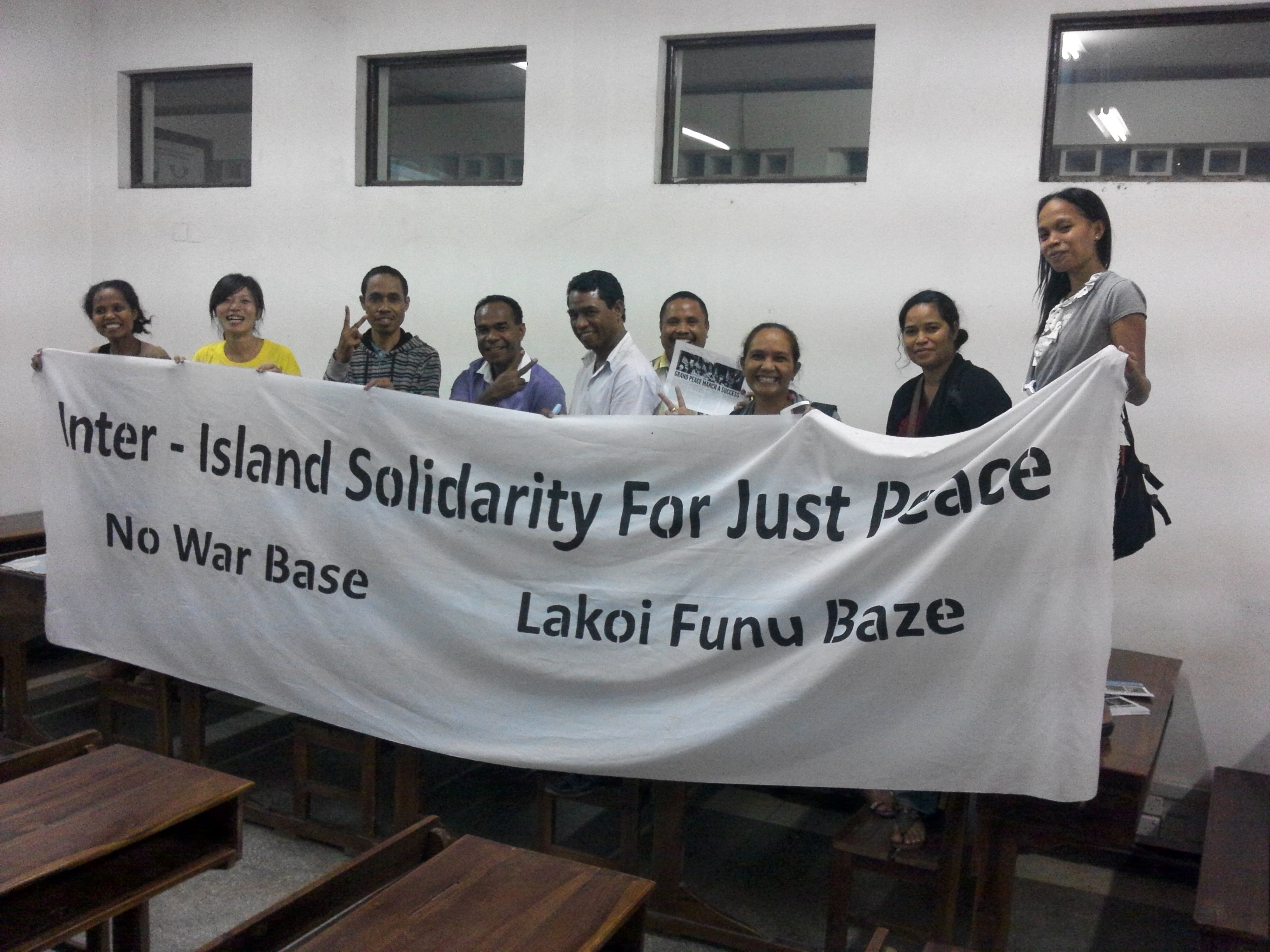
Speech in the Peace Study class with Graduate Students in University of Timor Lorosae 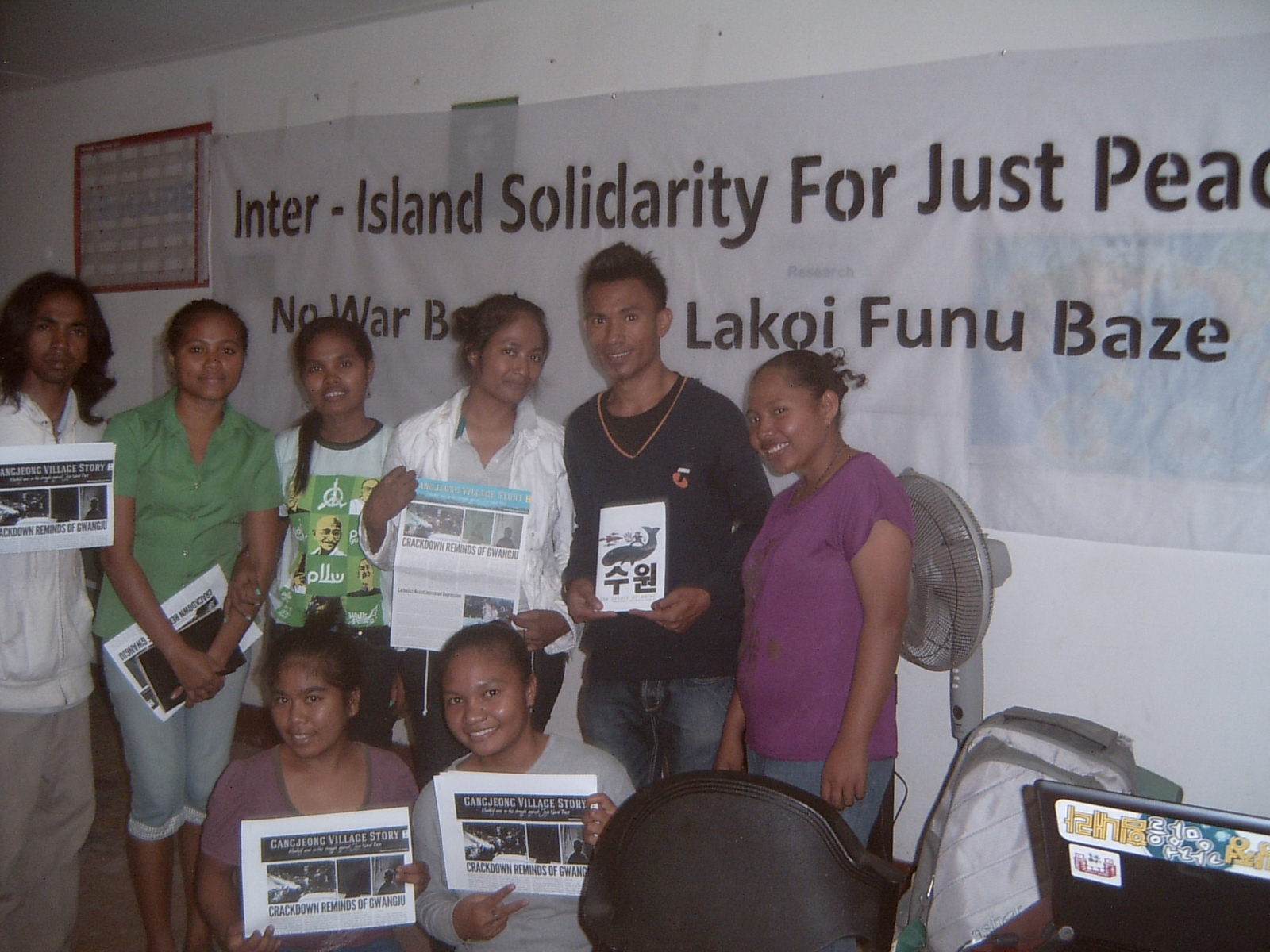
Sharing of Gangjeong struggle with the group of Women Peace and Leadership 
Sharing with the Human Right Groups in Timor
-
2013 Gangjeong Grand March for Life and Peace calls you: July 29 to Aug.4
UPDATE: Please notice that the official dates are changed from July 29 to Aug. 4, Sunday.
The July 29 to Aug. 3 program with the cultural festival in the Jeju City on Aug. 3 is same. But people will gather in Gangjeong on Aug. 4 to create a human chain between the east and west tips of the naval base construction area (1,500 km) from noon to 12 pm. Click here for more details on Human Chain on the day. Dir. Cho Sung-Bong, a movie director, currently works on the acclaimed documentary on Gangjeong titled, “The Gureombi Wind Blows,” will take air camera shots on human chain scene using unmanned helicopter and will put all the names of participants in the movie’s ending credit. Even though you may not be able to physically join the march and human chain. please send us international solidarity messages(up to 100 words)/photos/videos through gangjeongintl@gmail.com by no later than July 20. All the messages will be publicly shared. Please see the bottom for the details of optional programs after the human chain on Aug. 4.
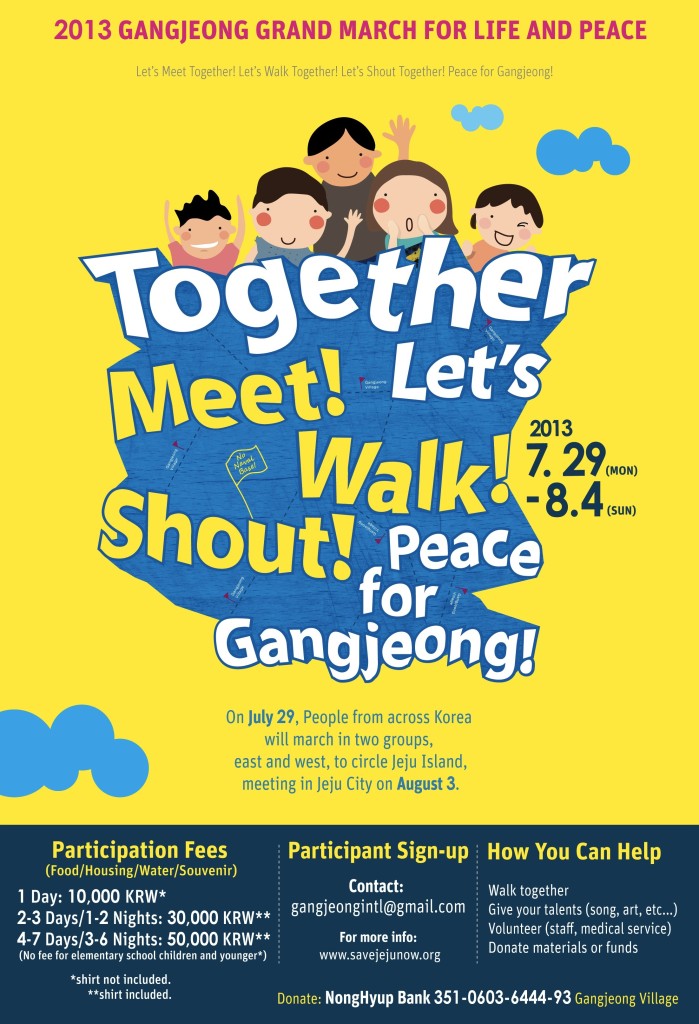
Click the poster for a larger version. * Internationals who can physically join the march and want to contribute the march with one’s talent/work, please see the below translation.
* Internationals who want to support the march by sending solidarity messages of up to 100 words and/or photos and/or videos, please send those to Gangjeongintl@gmail.com no later than July 20 (Please see the 2012 event here, and solidarity messages, here)
* For all questions and suggestions on the matters including those not explained in the below, please contact gangjeongintl@gmail.com
* Thank you to be with us!
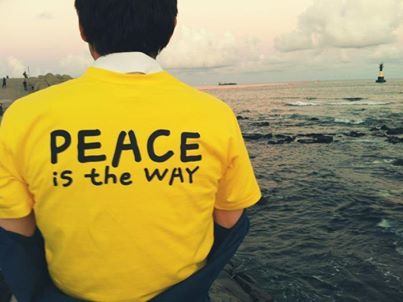
2012 Gangjeong Grand March for Life and Peace (Image: Choi Hye-Young) 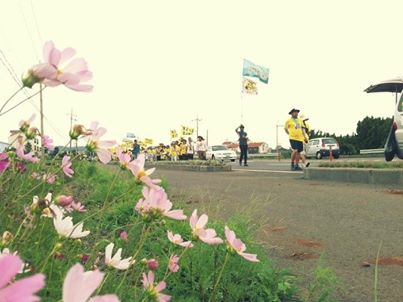
2012 Gangjeong Grand March for Life and Peace (Image: Choi Hye-Young) # A translation of most part of an original Korean script
Proposal for co-sponsoring and participation
in the 2013 Gangjeong Grand March for Life and Peace
By the Coordinating Committee for 2013 Gangjeong Grand March for Life and Peace
June 7, 2013
Summary (translated) of introduction letter
The Opposition struggle against the Jeju naval base project hits its 7th year. [..]
Since the Presidential election last time, the response measure by the prosecutors and police has been transformed into consistent drastic policies. The navy is openly enforcing construction(destruction) despite people’s criticism on illegal construction(destruction). Some make propaganda that the struggle to stop the naval base project is in fact finished as the Park Geun-Hye Government that has asserted on the justification of the Jeju naval base project was launched. [..]
Everyday is a continuation of hard struggle in Gangjeong nowadays. The police make routine of arrest and the prosecutors who are in line with them are oppressing the opposition struggle with unreasonable issuing of arrest warrants and bombs of fines. [..]
However, we cannot give up. It is because we trust that the peace of Gangjeong is the peace of Korea and our struggle to stop the Jeju naval base project is to be the voice for the peace of the northeast Asia and world. It is also because we know that the way we are walking now would be a step to stop the ‘gochak’ (meaning ‘detaining by encircling’) of destructive military domination and resuscitation of anti-human state violence. [..]
Now, we, succeeding the year of 2012, want to propose to gather people’s voice for peace once again.
We are to gather the voice to inform the injustice of the Jeju naval base project and to appeal for peace to be saved, while we walk around of the spots of Jeju for five nights six days during the hot summer.
Please join the 2013 Gangjeong Grand March for Life and Peace in which we feel pain together, walk together, and talk on our peace together!
Please be a part of one strong voice for peace, again!
Details of proposal
Please become a co-sponsoring groups for the 2013 Gangjeong Grand March for Life and Peace
□ The role of co-sponsoring group
▶ Registartion of more than 100,000 KRW (about 90~100 USD), which is for co-sponsoring of the event
▶ Each representative of co-sponsoring group is chosen as a member of the Peace Representative Board. One has to join march for more than a day
▶ Encourages its members to join the march and organizes support material and fund.
▶ It is planned that each co-sponsoring group is individually named in poster, web poster and media.
▶ The groups that have been confirmed of co-sponsoring and that are in discussion as of June, 2013:
The Gangjeong Village Association,
Jeju Pan-Island Committee for the Stop of Military Base and for Realization of Peace Island (31 groups)
National Network of Korean Civil Society for Opposing to the Naval Base in Jeju Island (11 groups)
Open Network (Inc.)
Gangjeong Friends
Gangjeong peacekeepers
Professors’ Association for the stop and re-examination of Jeju naval base construction
Korean Writers’ Association
□ Contact
Go Gwon-Il, chairman of the Gangjoeng Villagers’ Committee to Stop the Naval Base Project
Boo Jang-Won, Director of coordination, Jeju Pan-Island Committee for the Stop of Military Base and for Realization of Peace Island
Kim Duk-Jin, National Network of Korean Civil Society for Opposing to the Naval Base in Jeju Island
# For internationals, please contact Gangjeong village international team: gangjeongintl@gmail.com
□ Plan on Gangjeong Grand March for Life and Peace
I. Summary
(1). Purpose
– It is to disclose the betraying behaviors of the navy and government that enforce construction (destruction) under the false cause of ‘national security’ and Woo Keun-Min Island government that connives those and in line with them. And it is to gather the public fury on it (* The election on the Island governor is in 2014. Currently the public support on the Island governor Woo Keun-Min is low)
-It is to form a public discussion on the possibilities of militarization of Jeju by the Jeju naval base project and of occurrence of military conflict in the northeast Asia. It is to expand to the public the need of continuation of the struggle to stop the naval base project.
-It is to share the mutual relationship among state, human rights, democracy, we remembering that state violence during the 4·3 uprising is recurred during the current enforcement process of the naval base project .
(2). Title of the event
2013 Gangjeong Grand March for Life and Peace, “Let’s meet [also can be translated gather] together! Let’s walk together! Peace for Gangjeong!”
(3). Sponsor and Host
-Sponsor: The Gangjeong Village Association, Jeju Pan-Island Committee for the Stop of Military Base and for Realization of Peace Island (31 groups), National Network of Korean Civil Society for Opposing to the Naval Base in Jeju Island (11 groups) etc.
( It is expected that the titles of groups will be added in the future)
-Host: The Gangjeong Village Association, Jeju Pan-Island Committee for the Stop of Military Base and for Realization of Peace Island (31 groups), National Network of Korean Civil Society for Opposing to the Naval Base in Jeju Island (11 groups)
(4). Program
Eve festival: 7 pm, July 28 (Sunday), 2013, Village Ceremony hall, Gangjeong Village
Grand March: July 29 (Mon) to Aug. 3 (Sat), 2013: For five nights six days
Nationwide citizens’ cultural festival to demand the revocation on the Jeju naval base project: Aug. 3 (Sat), 6pm, Tapdong square, Jeju City(tentative)
Human chain between the east and west tips of the naval base project area in Gangjeong: Aug. 4 (Sun), 12 to 2 pm, Gangjeong
(5). Participation purpose
The total number of man-days participation is expected 2,000 to 3,000 (except for the participants in the cultural festivals)
( 6). Ways of March
-People will be divided by east and west teams. The pilgrim will be focused on the inner roads of towns.
-There will be explanation on main histories, ecology, and environment of each region
– Some figures concerned with Gangjeong will be asked to join the march as the members of the Peace Representative Board.
( 7). Slogan
-Main slogan: “Let’s meet [also can be translated as gather] together! Let’s walk together! Let’s shout together! Peace for Gangjeong!”
-March slogan: Will be collected by group proposal or public solicitation, TBA
II. Guide on participation
(1). Application-phone, fax, email, internet registration
Internationals may contact the Gangjeong Village International team for application: gangjeongintl@gmail.com
# All applications will be collected into the briefing room of the Gangjoeng Village Association
(2). Participation fee
1) Per one person
– 1 day participation: 10,000 won (T-shirt not included)
– 1 night 2 days~ 2 night 3 days: 30,000 won (including T-shirts)
– 3 night 4 days~6 night 7 days: 50,000 won (including T-shirts)
# No Fee. Children elementary school-aged and under (T-Shirt not included)
# All meals, one bottle of water per day, wristle (to protect from hot sunlight)
2) Bank account for participation fee and support fund
: Nonghyup 351-0603-6444-93 (Beneficiary: Gangjeong Village Association)
Internationals can pay in cash on the very day(s) of participation.
(3) Accommodation
In principle, commmon tent
However, bringing individual tent is OK
An individual should prepare for one’s sleeping bags etc.
(4) March course
– It will be about 20 Km march a day.
– As possible as even road, considered of family participants
– On the last day (Aug. 3), march as possible as all spots of Jeju City
– Detailed course will be known later.
(5) Individual participant preparation
– Sleeping bag, washing stuff, hat, individual tent(choice) etc.
III. Organization of march team
(1) March team
Peace Representative Board (5 to 10 personnel for each day), march chiefs (full and daily), overall management on march, march director(practical business), support team, medical team, guide team, record team, administration team
(2) Briefing room
Director, registration team, meal team, meal-supply team, finance team, public relation team
IV. Main event program
(1). Eve festival
– Date: 7pm, July 28(Sun), Gangjeong Village Ceremony hall
– Basis: sharing the meaning of peace and gathering the will to stop the naval base project
– Main content: resolution speech, sharing meanings, introduction of participants, concert, peace ceremony.
(2). Press conference at the start
– Date and time: 8:30 am, July 29 (Mon), Gangjeong soccer field
– Content: Statement for citizens and demand on the revocation of the naval base project
– Introduction on some figures and speeches
– Main content: Speech by representative, statement, ceremony to gathering the sea water of Jeju, photo
(3).Cultural festival in the summer night
-Date: Aug 1 in Kimnyong (east team)and Aewol (west team)
– Content: Encouragement of local residents’ participation
(4). March program
– Public solicitation on photos, writings from the 2012 march participants, prize and recognition is given (Please contact gangjeongintl@gmail.com for subscription)
– Peace postcard to oneself: read in the festival and mailing
– Collecting sea water in the main march regions: Water will be collcted in cermony in the festival.
-etc.
(5). Cultural festival to revoke the Jeju naval base project
-Date/ Time: 6 pm, Aug. 3(Sat). Topdong Square, Jeju City (planned)
(6) Peace human chain: noon to 2 pm, Aug. 4 (Sun), Gangjeong village, in front of the Jeju naval base project committee building complex ( from Gangjeong stream in th east to the Gangjeong port in the west)
* Human chain is the end of official event of the whole march
(7) Optional program in Gangjeong on Aug. 4 (Sun)
7 pm: Korean traditional yard square in front of the Gangjeong Village Ceremony Hall
After 2 pm: Taste on the Peace of Gangjeong (free trip on the places of the village, Gangjeong stream water leisure)
-
Gangjeong International Team Hosts International Solidarity Talkshow
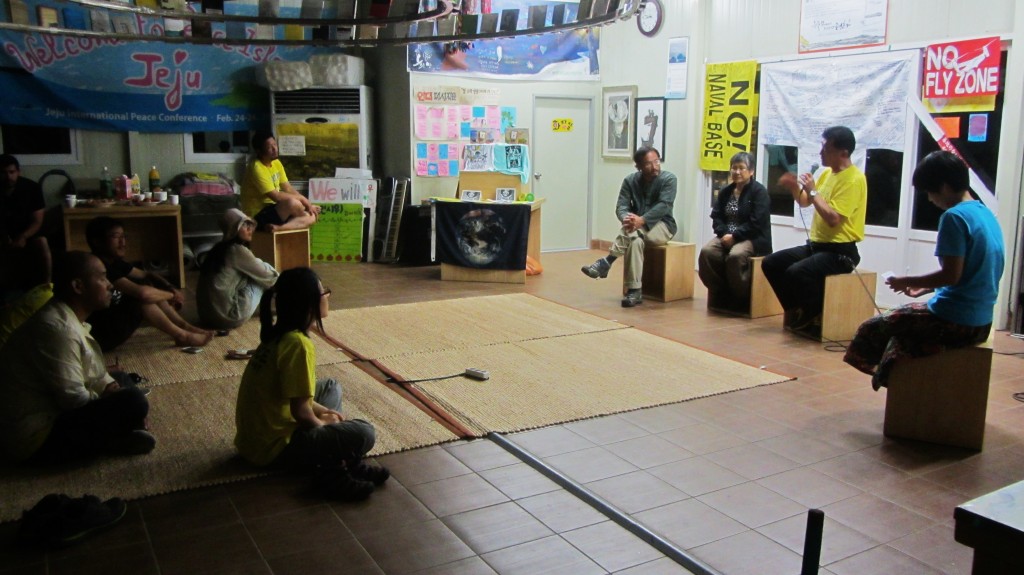
Brother Song, Jeong Young-Hee, and Mayor Kang chat in the Gangjeong Peace Center. On Wednesday, June 12, The Gangjeong International Team hosted an International Solidarity Talkshow during the daily candlelight vigil/gathering time in the Gangjeong Peace Center. The show highlighted recent solidarity trips taken by Gangjeong villagers and activists. There were three guest to the “show”. The first was Mayor Kang, who recently returned from Berkeley, California, where he attended and participated in the Moana Nui 2013 Conference on June 1 and 2. Moana Nui is an international solidarity gathering, hosted of people from by the International Forum on Globalization (IFG) and Pua Mohala I Ka Po, in cooperation with Oceanic Coalition of Northern California (OCNC). The theme was “PEOPLES OF THE PACIFIC–CONFRONTING MILITARIZATION, RESOURCE THEFT, GLOBALIZATION & THE PACIFIC PIVOT”. 45 speakers from 20 nations were there, including Mayor Kang, who spoke about the Gangjeong struggle as a Pacific resistance movment.
Second, Village Women’s Committee Chairwoman Jeong Young-Hee, who recently returned from an extensive speaking tour across the U.S., including Hawaii. For around 20 days starting at the end of April, she visited 6 different areas including Hawaii, Boston, Maine, New York, San Francisco and LA. There she shared about Gangjeong and her personal struggle at a variety of events, including a shared talk with Professor Noam Chomsky. And third, Dr. Song Kang-Ho (Brother Song) who has just come back from a trip to Okinawa. He was invited for May 18 which was the 40th anniversary of the reversion of Okinawa from U.S. Control back to Japanese administration. Aside from joining the events, he visited many areas to share about Jeju and talk about the movement for demilitarized peace island solidarity. For International Team member Silver was the host and emcee for the night, creating both a fun and thoughtful atmosphere. The “stage” was decorated with signed flags and signs of solidarity which the guests brought back with them.
The evening began with a trivia contest, with questions related to trips or the trip areas. Prizes included Jeju tangerine chocolate, solidarity t-shirts, and Indonesian coffee. After that each person was asked to give a 5 minute summary of their trip with pictures if they had them. It closed with a question and answer time.
During his talk and while answering questions, Mayor Kang said that he was impressed by the progressive atmosphere of Berkeley and felt that although it was home to many nobel prize winners, many people lived very frugally and not in a flashy manner. He also shared that he met many people from across the pacific ocean especially from small islands, and from them he found that they too were suffering like Jeju because of the endless pursuit of capital, neo-liberalism, and militarism. And they were all victims of war during WW2. He said that America claims they are working for “world security” with a “peace force” but in reality they are tormenting these small islands. He said he believes that Inter-Island Solidarity for Just Peace, beginning with a triangle of Okinawa, Taiwan, and Jeju is possible, because at the conference he felt a pressing need for forging bonds of solidarity at the conference. He also shared that in Berkeley there was a large 2000 year-old-tree which had a large hole in it that he could even climb inside. They were conserving that tree there and he was impressed and respected their effort to preserve their environment. On the other hand, I felt sad that America keeps its own values but at the same time seeks to destroy others values.
Among other things, Chairwoman Jeong told a story about an almost 70 year old native woman activist who she met in Hawaii and was very impressed by. She lost her parents when she was very young. Even back when her grandfather was still alive, that time was the 100th anniversary of U.S. colonization of Hawaii. Until now she has been working with dedication to recover Hawaii and has been to prison for her struggle. Also she met many Korean-American activists in the U.S. and was very impressed that even though Gangjeong is not their hometown they work hard to fight for Gangjeong. She said she was encouraged a lot by many American’s support for the Gangjeong struggle, but at the same time many overseas Koreans and Korean-Americans who were indifferent. She said that she even yelled at one guy who seems like a Korean government agent. She also shared that she learned a lot from the experience and she hoped that other villagers would get a chance to do the same.
Finally, Brother Song talked about the similarities between Jeju, Taiwan, and Okinawa. He said that all of them have similar histories and are suffering by powerful countries in similar ways. In the effort to create the Inter-Island Solidarity for Just Peace Movement, he suggested that we start with these three places as a “trial triangle”. He told the story of an island controlled by Taiwan called “Lanyu” were China discarded nuclear waste there without discussion. It is ironic that all of the most beautiful islands are destroyed by powerful nations. He then shared that the islands which are weaker than Jeju need our solidarity and experience. Meanwhile, Okinawa which has fought for more than 68 years has managed to get some land back from bases but all the land is very polluted. However, more than land contamination, spiritual contamination is more dangerous. In Okinawa, there is an place called, “American Village” where the land has been returned. But the land was contaminated and the economy was dependent on the base, so the people struggled and eventually created an American style village to service U.S. military members, so that they could survive. He said that we need a strong vision for peace so that even if our land is contaminated and the base is built our spirit will not be contaminated. For example, in Gangjeong we can create spaces for peace activists to migrate, give land for refugees, build a peace park, and do peace education, basically creating one big peace village. To gather islands for the Inter-Island Solidarity for Just Peace movement, he suggested sailing on a boat between the islands. He also invited people from around the world to join the every-seven-year-event of the WCC (World Council of Churches) in Busan, Korea this October, where Gangjeong and the Inter-Island Solidarity for Just Peace Movement will be holding a workshop during the forum.
-
UN Special Rapporteur on Human Rights Visits Gangjeong
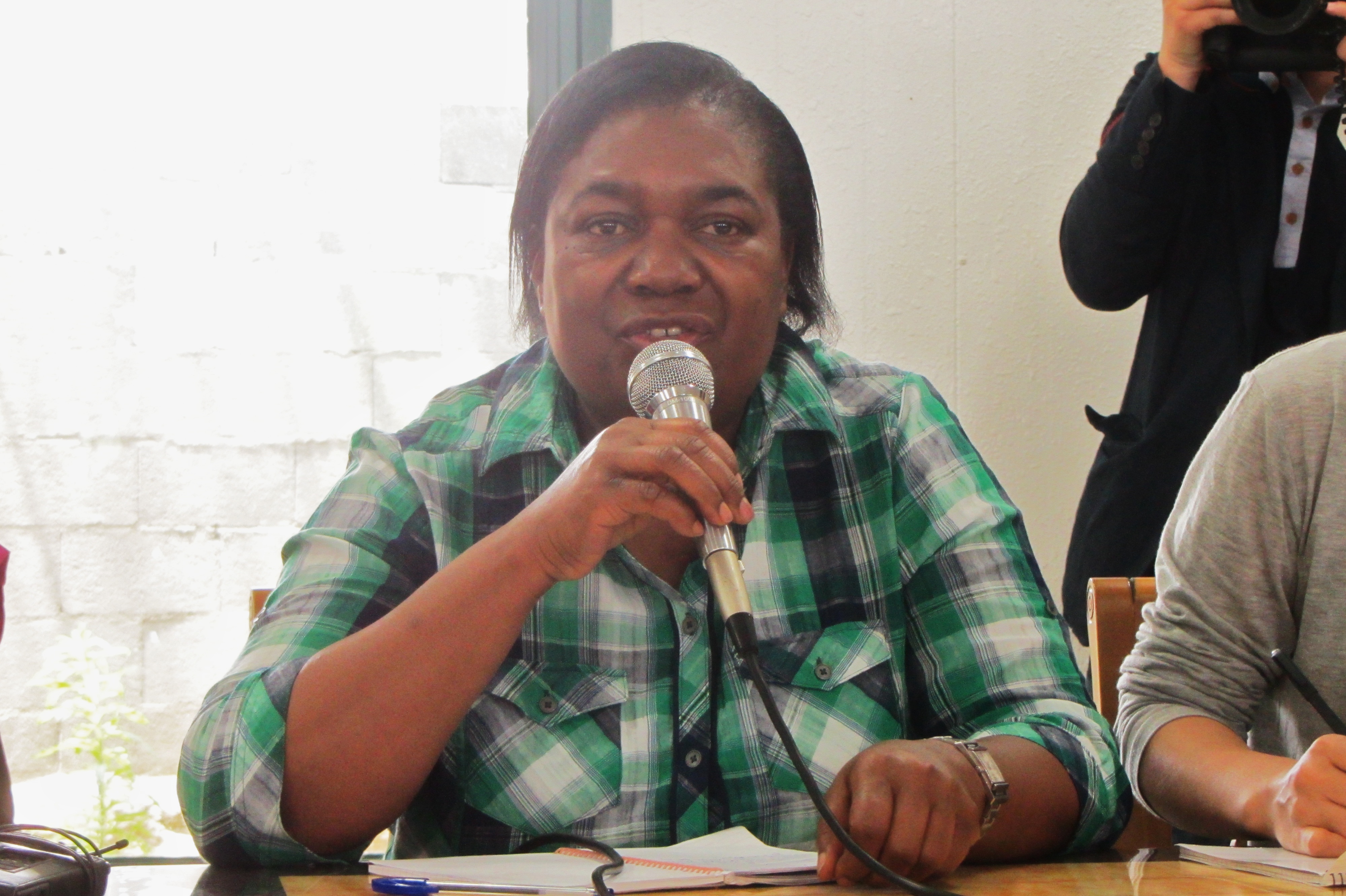
Margaret Sekaggya, UN Special Rapporteur on Human Rights, Introduces herself to Gangjeong residents. On June 4, 2013 Margaret Sekaggya, UN Special Rapporteur on Human Rights, visited Gangjeong to meet with villagers and activists and see the situation. The visit came as part of a two week visit to South Korea, visiting Korea’s unfortunately numerous sites of struggle for human rights and justice, such as Milyang and Gangjeong.
In the afternoon, from 1 p.m. to 3 p.m. a meeting was held in the village ceremonial hall with the villagers and activists to hear of their struggle. Sekaggya said that she will take her findings from her visit to Korea and would compile a report to be released in March of 2014. At that time the report will be released to the Human Rights Council in Geneva as well as to the Korean government and publicly.
Upon her arrival many reporters and broadcast news personnel were waiting but following a brief introduction were made to leave and the doors were shut, so that the villagers could speak in private without press intimidation.
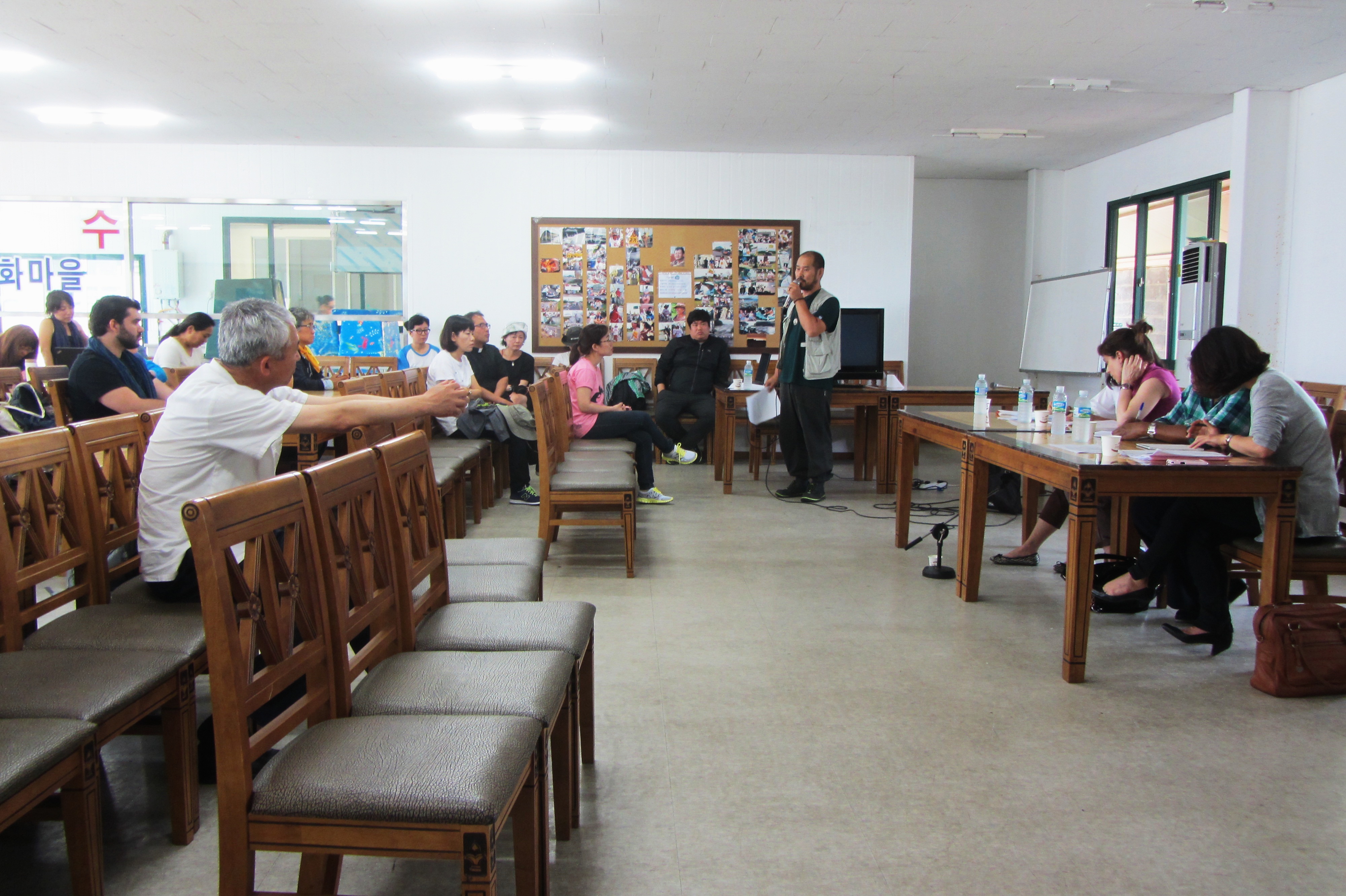
Village Anti-Base Committee Chairman, Goh Gwon-Il, begins the proceedings. The proceedings were emceed by Village Anti-Base Committee Chairman, Goh Gwon-Il who began giving a detailed overview of the history and facts of Gangjeong and the base project until now, such as the first fake vote and the second real vote where 94 percent of the 725 villagers in attendance voted against the base.
Descriptions of military, construction, and police harassment of villagers and activists followed. A video from 2011 of naval soldiers harassing and fighting with villagers was shown. Then a video of the 4-on-1 water assault on and beating of Dr. Song Kang-Ho by Coast Guard SSU Special Unite Divers in 2011. Next a video was shown of Villagers and activists attempted to climb a barge to talk to the workers and navy, and being beaten and pushed from the boat by workers and the navy.
Next videos were shown of the recent crackdown on the sit-in tents near the gate, including the near hanging on Mayor Kang by careless police and public workers, as well as the police pushing Villager Mi-Lyang off a 6 meter high ledge. Then Mi-Lyang, who is still in the hospital for recovery, came to give her testimony of the situation. It was clearly very difficult for her to speak of the recent traumatic event.
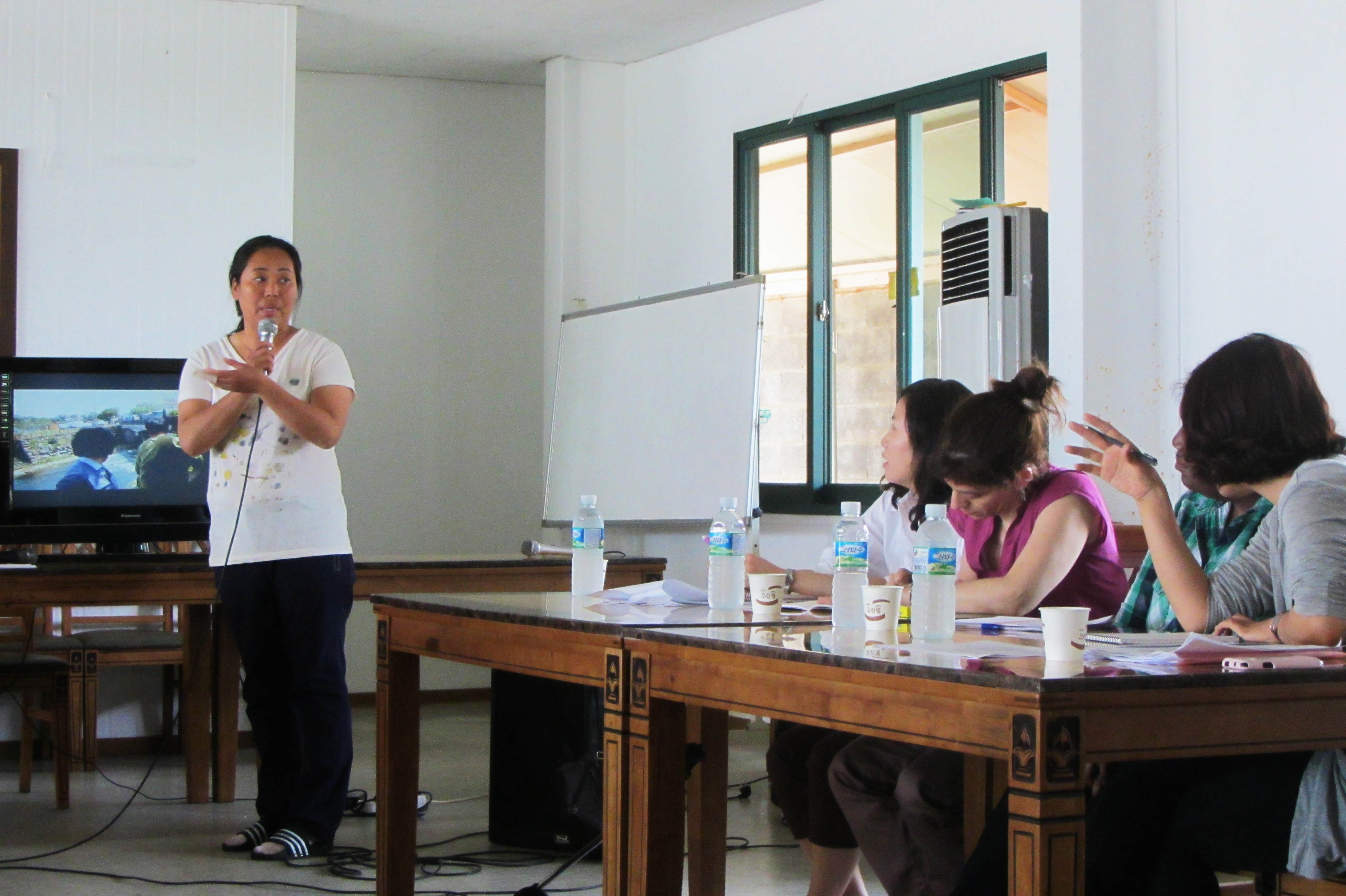
Villager Kim Mi-Lyang tells about her traumatic fall at the ends of the police. Then, Catholic Fr. Kim Sung-Hwan came to speak about and show videos of the oppression on the Catholics, including the near death of Father Mun in April of 2012 as well as the pushing over of Father Mun during communion destroying the sacraments, general police oppression and disruption of the daily catholic mass, including the outrageous use of pepper spray on those attending the mass.
Next, tangerine farmer and chairwoman of the Village Women’s Committee to Stop the Base, Jeong Young-Hee, came to talk about and show pictures and videos of further struggles and injuries from police violence as well as base construction pollution damage to crops. After that, Activist Bok-Hee came and talked about oppression on activists including the police and security thug violence at the construction gates, displaying the many injuries. She also emphasized the double standard, that when there are many cameras or visitors, the police are very gentle and polite but when no one is looking they are violent and rude. Next, Activist Youn-Ae came and gave a personal testimony about her life as an anti-base activist and oppression she has faced in Gangjeong.
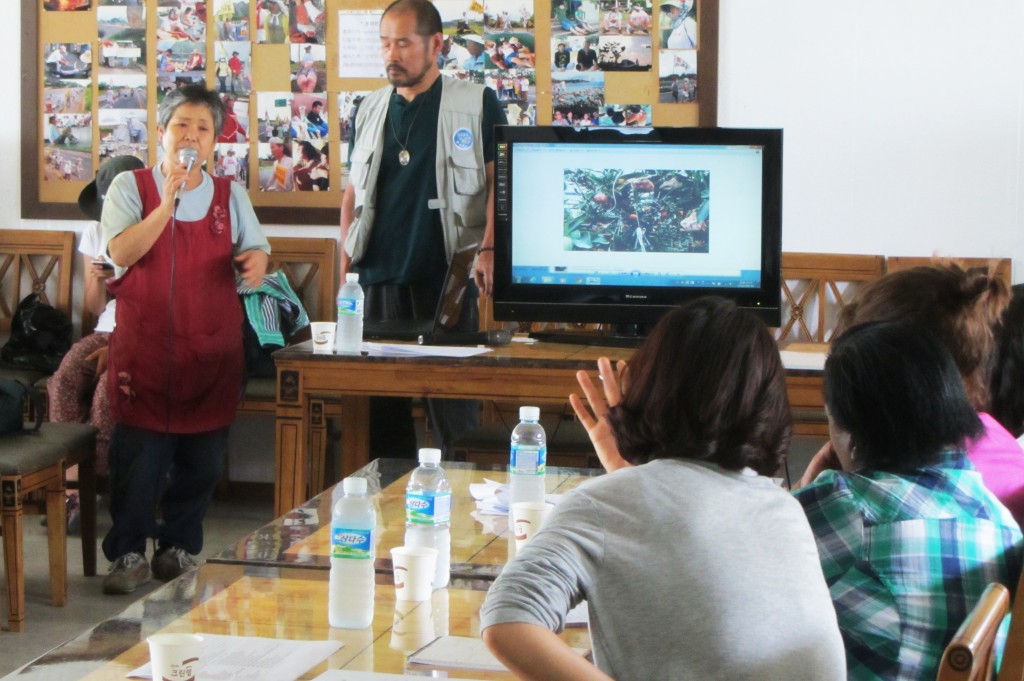
Tangerine farmer and chairwoman of the Village Women’s Committee to Stop the Base, Jeong Young-Hee addresses the panel. Finally, Activist Sung-Hee came and talked about oppression on internationals, emphasizing detail the stories of Benjamin Monnet and Angie Zelter who were targeted and forcefully deported. She also talked about the recent re-entry denial of long-term Taiwanese Gangjeong resident, Emily Wang, as well as the more than 20 other entry denials and deportations related the anti-base struggle.
After the nearly two hours of detailed explanation by Gangjeong villagers and activists there was a general question and answer time. The UN visitors thanked the people for their testimonies and information and asked what kind of things they would like to see in the report, such as concrete statements or actions or resolutions. Although there wasn’t much time to comment 5 people responded with suggestions.
Finally, Margaret Sekaggya thanked everyone again and apologized for the short time. She also said she felt very well received and also thanked the organizers for organizing everything so well. In the end, she wished the people the best in their continued struggle. Then she went out for a short tour of the village before departure.
-
UNESCO totally cheated by Jeju Island Government
Related links: [May 27 to 30] A Renewal of the UNESCO Biosphere Reserve Status? The Jeju Sea is being killed now.
Navy and companies’ illegal dismantling of damaged caissons on the sea
(Source: Jeju Internet News, May 29, 2013/ Original source: Gangjeong Village Association)
1. Maintenance of UNESCO Biosphere Reserve despite massacre of nature?/ People’s letter to the UNESCO
Despite great mass killing of UNESCO sea creatures in the Gangjeong Sea, Jeju, it is reported that the UNESCO International Coordinating Council of the Man and the Biosphere program (MAB) adopted the report by the Jeju Island government in its evaluation on May 28, 2013. The evaluation is held every 10 year. The Jeju Island became to continue to hold the title of the UNESCO triple-crowned: The Biosphere Reserve, World Natural Heritage and Geology Park. Please see the very related and important post regarding the matter of the UNESCO renewal , here.
The Jeju Island was designated as the Biosphere Reserve in Dec. 2012. The total designation area is 30.94㎢, which is about 45% of the whole area of the Jeju Island, It includes the Halla National Park, Youngcheon (Young Stream), Hyodoncheon (Hyodon Stream), Moonseom (Moon Island), Beomseom (Beom/ Tiger Island), Seopseom (Seop Island) that were designated as the CORE Biosphere Reserves in 2012. (See the same article of the Jeju Internet News linked above)
The status of the UNESCO Biosphere Reserve in the Jeju Island. The scarlet areas and spots indicate the core zones of the Biosphere Reserve: Mt. Halla, Beom, Moon and Seop Islands. The blue areas are buffer zones while the pale blue areas are transition areas. (source: Jeju Internet News, May 29, 2013)
The National Network of Korean Civil Society for Opposing to the Naval Base in Jeju Island has sent a letter to the UNESCO MAB secretariat as of May 29, to request the UNESCO ‘objective reviews on the Jeju Biosphere Reserve,’ concerning about the ‘destruction and pollution of the Jeju Biosphere Reserve in relation to the Jeju Naval Base construction.’ Please see the letter in English in the site (Please scroll down mouse until you see the English part).
In its letter, it first raised on the matter of ‘inconsistent maps of the Biosphere Reserve Buffer Zone’ around the core Biosphere Reserve of the Beom Island (Tiger Island):
‘Inconsistent maps of the Biosphere Reserve buffer zone brings confusions and raises doubts on the Government’s performance on monitoring the management and preservation of the entire Jeju Biosphere Reserve.” (See the letter for details)
It also made clear that the ‘sea route of the Jeju Naval Base would cut through the buffer zone’: ‘In the last World Conservation Congress held in September 2012, the Government insisted that the Jeju Naval Base construction does not violate the Biosphere Reserve. However, in any of above mentioned three maps, the sea route of the Jeju Naval Base would cut through the buffer zone, which would bring negative impacts on the Biosphere Reserve. The Government did not mention about these concerns in its Periodic Report submitted in September 2012.’
Thirdly, it raised on the matters of ‘pollution and damages of adjacent waters by the Jeju naval base construction,’ with the examples of unreliable silt-protectors and mass-killing dismantling works of damaged caissons on the sea.
Despite the letter, according to the the Jeju Island government who stated on May 29 , “the UNESCO MAB-ICC made an overall evaluation that ‘the Jeju Island is faithfully carrying out the Biosphere Reserve network rules and regulations,’ according to its advisory committee evaluation result. The MAB-ICC adopted the periodic reviews from the six regions of Canada, Germany, India, Paraguai, Mexico, and Jeju Island, among 55 regions, without special demand items. It adopted periodic reviews from the other regions with recommendation and demand items.” the same article reads. (See the article)
According to the article, ‘the Jeju Island government delivered that it included the physical character of the Island’s Biosphere Reserve; types of creatures’ habitats; activities within the Biosphere Reserve; activities on study, monitoring; education & training and public relation; management, policy, budget on its biosphere reserve.’ It also added that it ‘introduced Gotjawal, Oreums, inner land wetlands, and soft coral habitats as the habitats of special concern, while introducing stone culture and sea-diving women’ lives as its traditional culture.’
Did they ever report on the current on-going destruction and killing of UNESCO Gangjeong Sea by the naval base construction(destruction)? Probably NONE but with lots of cheats ! The UNESCO is dammed to be cheated by the Jeju Island and ROK governments. You may see the ROK government document to the MAB-ICC, here, which conceals many serious matters of ROK government’s environmental destruction in the UNESCO Biosphere Reserve, especially in the Jeju.
2. People file for a lawsuit against the navy and Samsung
On May 31, the ROK Day of Sea, some groups such as the Office of Jang Hana, National Assembly woman, Hot Pink Dolphins, and the Gangjeong Village Association filed for a lawsuit accusing the ROK navy, Samsung and Daelim, especially in relation to the navy and companies’ massacre of sea creatures with their thoughtless dismantling works of damaged 6 caissons, which started on May 5, this year, the Children Day in Korea. (See the accusation document in Korean, here).
The groups along with the members of the Seoul and Gyunggi branches of ‘Gangjeong Friends’ also had a press conference in front of the Seoul Central District Prosecutors’ Office on the same day.
Jang Hana, National Assembly woman talking and holding accusation document against the navy and corporations such as Samsung C & T, during the press conference on May 31. People wore the hand-made hats of endangered species in Gangjeong by the naval base construction(destruction)
Jo Yak Gol, member of Hot Pink Dolphins and a peace keeper of Gangjeong speaks during the conference on May 31. (Source/ Original Source: Voice of People, May 31, 2013)
According to Jang Hana, National Assembly woman: “The navy’s behavior of contaminating the sea ecology system in the Gangjeong Sea, by its dismantling process of damaged caissons underwater, bringing the very poisonous cement powders and concrete lumps in the sea is in violation of item 2 of article 22 of the maritime environment management.
The item 2 of the article 22 of the maritime environment management defines that “nobody should leak contaminating material that occurs in the maritime space such as maritime facility, beach resort, and mouth zone.” The punishment for the violation of it is up to two years’ imprisonment or up to 20 million won fine.
The people also reminded that when the World Conservation Congress was held in Jeju, 2012, there was a controversy of environmental destruction on the damaged caissons by typhoons. At the time, Captain Yoon Seok-Hwan stated in the press conference, that the navy plans to “float damaged caissons and then dismantle and dispose those ON THE LAND or dispose those in the ways not badly affecting environment. We will NEVER use the way such as underwater blast.” (See a Korean article, here) .
Go Gwon-Il, Village chairman of the Stop the Naval Base Project speaks during the press conference on May 31. The banner reads, ‘Immediately stop the Jeju naval base construction (destruction) that destroys maritime ecology system. ‘(Source/ Original source: Newsis, May 31, 2013)
However, that promise has never been kept. The navy is openly dismantling those caissons ON THE SEA, carelessly blowing out poisonous cement powders and lumps into the sea. Its disastrous result could be seen on the SOS teams’ May 15 video. “Even though the navy and Samsung say that they would dredge the cement on the sea bottom, there is really no way to dredge all the chopped-up parts of cement because those powders are spreading far into the sea by the strong currents of the Gangjeong Sea. It is already illegal to throw down concrete cement, poisonous waste, into the sea.” (from people’s accusation document)
3. Three recent important videos on the navy’s destruction of Gangjeong sea
(1) The navy and companies’ illegal dismantling of damaged caissons on the sea
It is a vivid scene of navy’s illegal dismantling of damaged caissons on the sea, which started on May 5. (Video by Moetppuri Park, edit by Ryu Dong-Kyun)
Seven caissons were destroyed by the typhoons such as Bolaven on Aug. 29, 2012. The whole production costs of those caissons are 35 billion won. The ROK Ministry of Construction and Traffic has concluded in 1998 that the caisson construction method is impossible in the southern part of Jeju, after the result of a year’s investigation. It is because of severe typhoons and currents to the total destruction of harbors in the Seogwipo area, the southern part of Jeju. (See the recent Korean article, here). Especially, the Gangjeong village is of a protruded out geography in its coast. The villagers have warned the navy numerous times that the village geography itself is impossible for any huge harbor, not to mention naval base. Despite that, the navy has enforced the construction (destruction). It is only forthe profits of big corporations such as Samsung.
(2) The UNESCO Gangjeong Sea being killed by the naval base construction (destruction)
(Video by Save Our Sea team on May 15, 2013)
‘While heavy metal-poisonous materials such as leaking earth and sands, concrete lumps and cement powders are injected into the sea as they are by the illegal naval base construction(destruction), the silt protectors never properly work because of unreliable installation and restoration of their damaged status… The Gangjeong Sea where the endangered species such as the Indo-Pacific bottle nose dolphins, red-feet crabs, soft corals have been playing is being killed. There hardly is no trace of living creatures in the bottom of the sea. Only sediment materials can be touched. The damage on the fisheries by the illegal naval base construction (destruction) is extended into Beophwan and Wolpyong, nearby Gangjeong’ (SOS. Source)
You may painfully compare the above video with the below which was taken in 2009, before the destruction of sea by the naval base construction.
(3) Illegal quarrying, transportation, and reclamation of sand and stones.
(Video by Kim Bok-Chul, edit and arrangement by Dungree(Park Sung-Soo)
The Jeju naval base project is already infamously illegal in the sense of dual MOU, violation of EIA, violation of law on the cultural treasure, layout flaw, manipulated fake simulation. It was disclosed by a construction worker last October that the Samsung C & T is building unreliable caissons, using the reinforce rods under-standard, which results in easy destruction of caissons by typhoons.
Not only that. The video discloses the illegal quarrying, transportation and land-filling of sand-stones by the companies.
On Jan. 31, this year, a peace activist, Mr. Kim Bok-Chul traced a truck from the Hwasoon port and Gangjeong and found that the stone-quarrying site located in the Mooreung-ri, Daejung-eup, Seogwipo City is illegal. Given the record, it can be estimated that tens of thousands of illegal sands and stones have been transported for 40 days around Jan. 31. Those illegal stones would never properly work in the basic construction of the base.
It has been also known that there are about nine transportation companies of which trucks commonly violate legal speed, freight amount, central line and traffic signs.
Putting sands and stones in the sea is also done in violation of the EIA. The silt-protectors have never properly functioned but rather contributed to the destruction of environment.
The navy and company should stop destruction of nature with illegal methods which are only for reduction of construction costs. The sea is of the soft coral habitats, which are ROK natural memorial NO. 442, as well as the UNESCO Biosphere Reserve.
While the Seogwipo Coast Guard is investigating on the illegality of sand and stones, the Seogwipo City and Seogwipo Police should also thorough examine the illegality of construction (destruction) rather than oppressing protesting people in violation of their human rights.
-
Morning with the Mayor | Organizing Notes
Reblogged with permission from: MORNING WITH THE MAYOR | by BRUCE K. GAGNON *
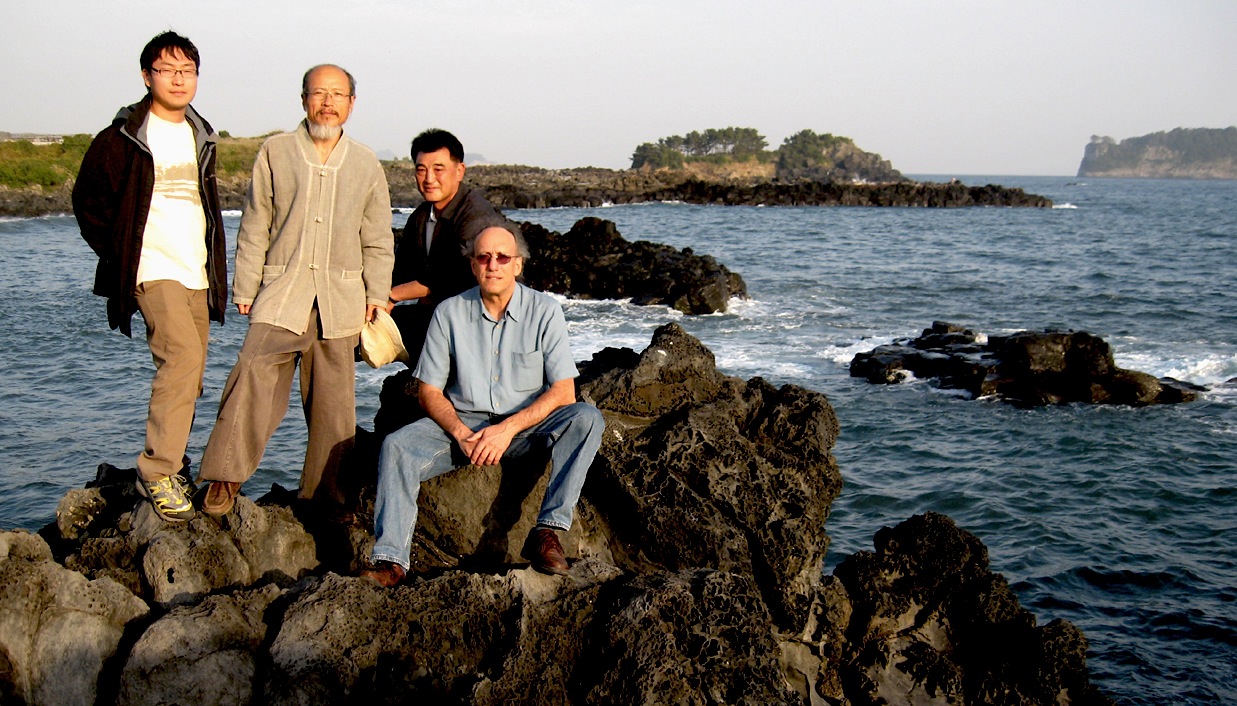
On my first trip to Gangjeong village Mayor Kang (just behind me in dark jacket) took me to see the place where the fresh water stream flows into the sea. This was to be one end of the massive Navy base now being built in the village. At that time I was able to see the undisturbed beauty of the coastline. I arrived in Berkeley, California last night about 7:30 pm and was able to join a group of conference participants at a Chinese restaurant where they were having dinner together. When Gangjeong village Mayor Kang saw me he rose and gave me a big hug. At that time there was no translator available so we didn’t get to have much conversation.
This morning at breakfast Mayor Kang arrived with a Korean professor from the university. The mayor had just come from doing an interview for Democracy Now which is supposed to air on Monday. Koohan Paik (Hawaii) was on the radio with the mayor. Koohan has been a great Jeju supporter and made it possible for the mayor to speak at this event on behalf of the village.
During breakfast the mayor told me that when I first came to visit Gangjeong he remembers me talking about space technology. He told me that he now understands much better what I was saying. He said he believes that the US is bringing the South Korean government into the military space program as a junior partner to help control China. I was happy to hear that he has put all the pieces together.
A translator took the mayor and I for a long stroll through the vast University of California campus. We went to the top of a huge bell tower that enabled us to see the entire San Francisco bay area. While we were looking out over the bay I told the mayor how much their non-violent resistance has inspired people all over the world due to their strong spiritual grounding. He told me that they made a conscious decision to act in that way to help them deal with the obvious depression and sadness that comes from the Navy base construction project. He said that if they were going to resist then they had to find a way to stay connected to what was good in nature and in each other. He offered to teach me the dances…
*Reblogged posts do not necessarily reflect the opinions or views of Save Jeju Now

